Sun news July 31: Sunspot region blasted an X14! Now it’s back
Sun activity is high this week, so far. There were 7 M flares in the past day. And check out the newcomer on the sun’s eastern, or incoming, side. Remember sunspot region AR3738? It produced an X flare and numerous M and C flares during its trip across the Earth-facing sun from July 5 to 17. Then the sun’s rotation carried it to the far side, where it produced an X14 flare! The flare – and its effects – were observed thanks to the Solar Orbiter spacecraft, which can see the sun’s far side even when we on Earth can’t. But guess what? The sun has kept on spinning. And now this powerful region is back in view! It has a new number: AR3774. The renumbered region produced an M4.8 before being labeled and fully in view. We wait to see if it will live up to its earlier incarnations. Meanwhile, it has competition from AR3772, which produced an almost-X flare over the past day, an M9.4. And region AR3768 just gave us an M7.7. There is a lot of magnetic potential on the Earth-facing solar disk right now. So there’s great potential for M and X flares. This is exciting, because we have already had an active sun with several good-sized M flares over the last few days. That means more CMEs are on the way, with perhaps more to come even as we wait for the train of solar blobs – the incoming coronal mass ejections, or CMEs – that are already expected at any moment (see Current Geomagnetic Activity, below). Stay tuned, sun-watchers and aurora-watchers. Get your gear ready. Clear skies to all!
Last 24 hours: In the past day (11 UTC yesterday to 11 UTC today), sun activity stayed at high levels thanks to seven M flares, including an M9.4 and an M7.7. The flares during our observation period (11 UTC yesterday to 11 UTC today) included seven M flares and eight C flares. The largest event of the period was the M9.4 at 19:38 UTC on July 30 from AR3772. The complete M flare list is:
• M1.5 at 16:28 UTC on July 30 from AR3766. R1 (minor) radio blackout over the Dominican Republic.
• M1.9 at 19:20 UTC on July 30 from AR3764. R1 (minor) radio blackout over the Mar de Cortés.
• M9.4 at 19:38 UTC on July 30 AR3772. R2 (moderate) radio blackout over the Pacific Ocean.
• M3.1 at 20:19 UTC on July 30 from AR3772. R1 (minor) radio blackout over the Pacific Ocean.
• M2.0 at 1:50 UTC on July 31 from AR3773. R1 (minor) radio blackout over the Philippine Sea.
• M4.8 at 5:23 UTC on July 31 from AR3774. R1 (minor) radio blackout over Myanmar.
• M7.7 at 6:46 UTC on July 31 from AR3768. R2 (moderate) radio blackout over India.
Active region AR3764 was the lead flare producer of the day with four flares, an M, and three C flares. Three active regions on the Earth-facing solar disk keep a delta magnetic region. AR3765 and AR3768 have a beta-gamma-delta magnetic complexity and AR3770 has a beta-delta complexity. AR3762 and AR3766 have a beta-gamma configuration, while the rest of the sunspot regions show an alpha or beta. Currently, the sun has 12 labeled active regions on the Earth-facing side. There are three newcomers: AR3772, AR3773, and the just labeled AR3774.
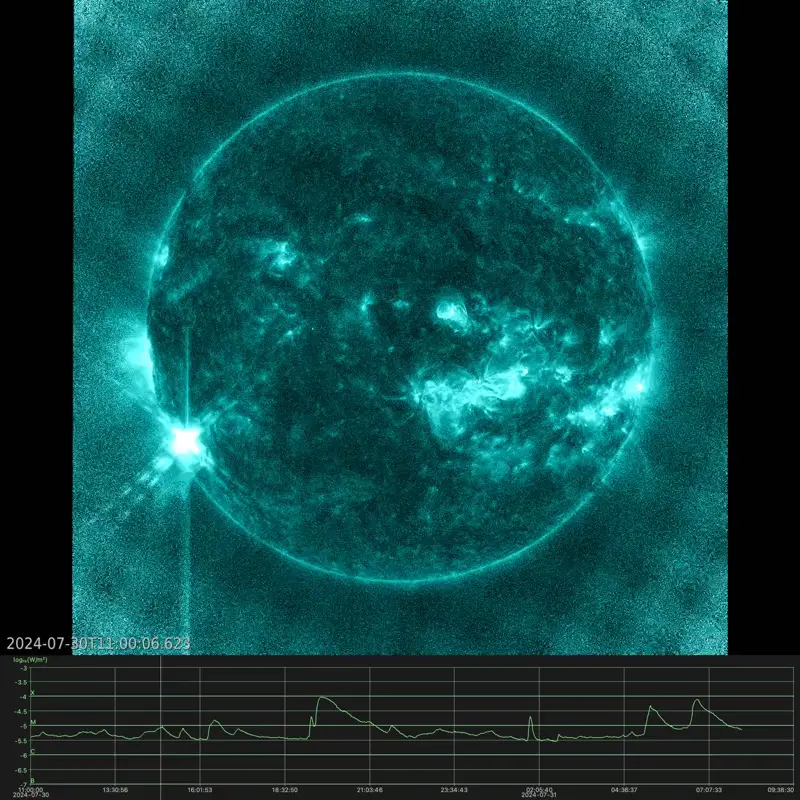
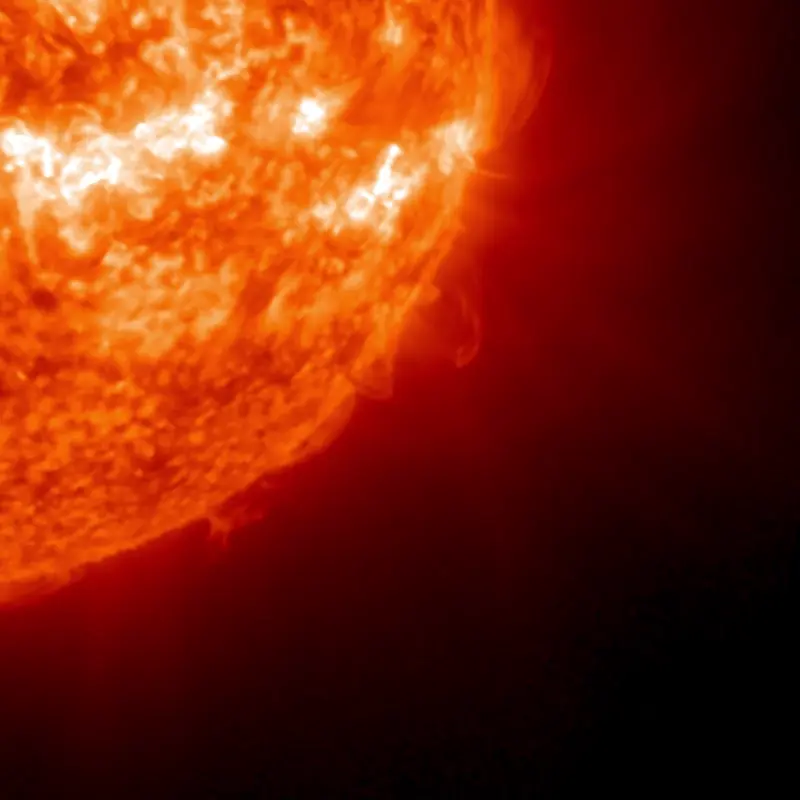
Sun news July 30: ‘Strong’ geomagnetic storm watch
A chunk of solar stuff hit Earth earlier today. Earth’s geomagnetic field reached the G1 (minor) storm threshold at 3 UTC on July 30 (late last night according to clocks in the Americas). And more is ahead today, especially for those in Europe. Spaceweather forecasters are calling for G1-G2 (minor-moderate) geomagnetic storming up to a G3 (strong) during the rest of today. The G3 storm is expected when the Americas are still in daylight. Will it last into tonight according to American clocks? Maybe. And will the storming be as extreme as those seen in May 2024 which caused auroras even as far south as our latitude here in Texas? Probably not. That was a G5 (extreme) event. Today’s event is predicted for G3 (strong). It is being caused by multiple coronal mass ejections (CMEs) hurled from the sun during July 28-29. Stay alert, aurora chasers! Bring those cameras out, take all those beautiful photos, and share them with the EarthSky community. The Enlil model shows four CMEs released in the past few days by our star. It created a cannibal CME, which is expected to reach Earth on July 31-August 1. Get ready for some aurora-watching. This is certainly true for higher latitudes, but it could also be true for northern-tier U.S. states. Stay tuned for updates.
Last 24 hours: Nine M flares, one of them an M8.7 flare and another one an M6.4 kept sun activity at high levels in the past day. Solar flaring activity during our observation period (11 UTC yesterday to 11 UTC today) was 18 flares, nine M flares and 11 C flares. The largest event of the period was an M8.7 at 12:55 UTC on July 29 from AR3762. The complete M flare list is:
•M1.6 at 12:22 UTC on July 29 by AR3762. R1 (minor) radio blackout over the Atlantic Ocean.
• M8.7 at 12:55 UTC on July 29 by AR3762. R2 (moderate) radio blackout over the Atlantic Ocean.
• M4.3 at 14:46 UTC on July 29 by unnumbered incoming region. R1 (minor) radio blackout over the Atlantic Ocean.
• M6.4 at 19:57 UTC on July 29 by unnumbered incoming region. R2 (moderate) radio blackout over the Pacific Ocean off the west coast of Baja in Mexico.
• M1.1 at 21:00 UTC on July 29 by AR3768. R1 (minor) radio blackout over the Pacific Ocean.
• M1.7 at 1:03 UTC on July 30 by AR3762. R1 (minor) radio blackout over the middle of the Pacific Ocean.
• M1.2 at 1:25 UTC on July 30 by AR3762. R1 (minor) radio blackout over the Philippine Sea.
• M1.3 at 1:32 UTC on July 30 by AR3768. R1 (minor) radio blackout over the Philippine Sea.
• M1.5 at 6:29 UTC on July 30 by AR3766. R1 (minor) radio blackout over northeast India.
AR3768 was the lead flare producer with five flares, including two M flares and three C flares. Two active regions on the solar disk, AR3766 and AR3768, have beta-gamma-delta magnetic complexity. AR3765 and AR3770 also gained a beta-delta magnetic complexity while AR3762 keeps a beta-gamma configuration. The remaining 10 labeled active regions on the sun’s Earth-facing side have an alpha or a beta complexity. There is a newcomer that emerged just below the equator in the southwest quadrant now numbered AR3771.

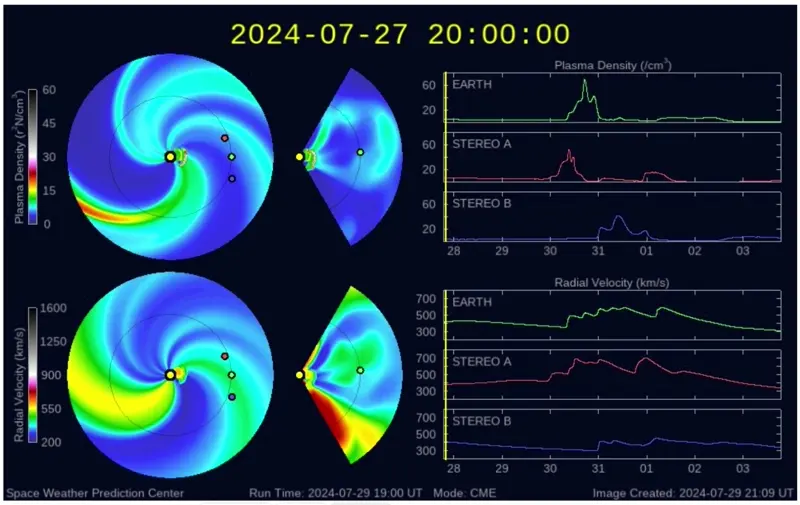
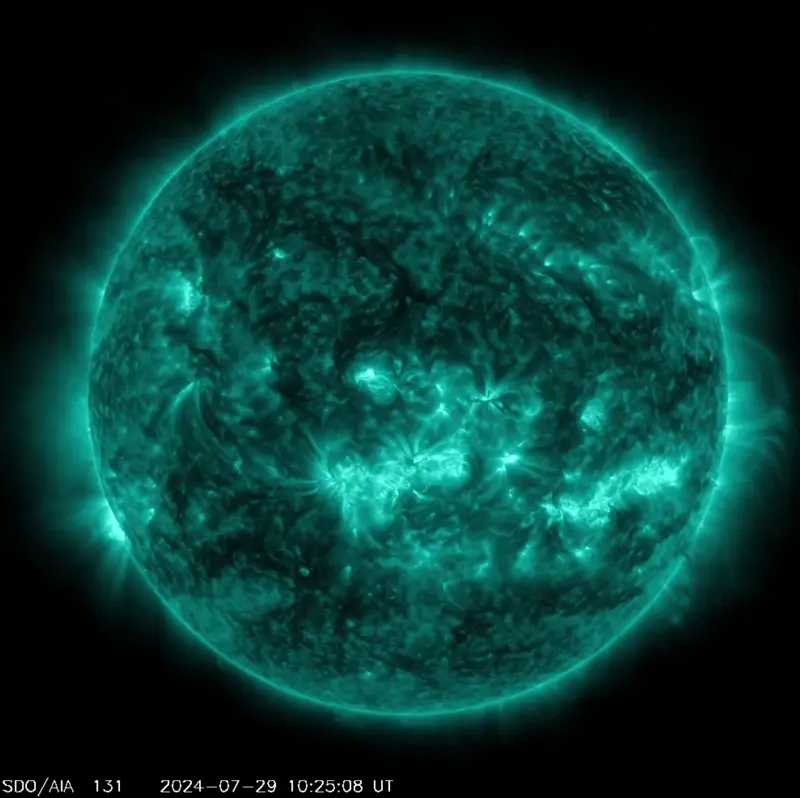
Sun news July 29: KaBOOM! X1.5 flare and sun stuff on the way
The sun released an X1.5 solar flare early this morning (2:33 UTC on July 29). This flare, along with many of the M flares over the past two days, has a coronal mass ejection (CME) associated with it. CMEs from July 27 and July 28, mentioned in the video below, created a cannibal CME, which is expected to reach Earth on July 31-August 1. We await the space weather forecaster analysis of the CMEs for the past 24 hours, but there are more than likely a few more on the way to Earth’s vicinity. With all of these CMEs and their resulting (expected) geomagnetic storms, it’s a good time to get ready for some aurora-watching. This is certainly true for higher latitudes, but it could also be true for northern-tier U.S. states. Stay tuned for aurora forecast updates.
Last 24 hours: Sun activity is high. Solar activity increased slightly over the past 24 hours (11 UTC yesterday to 11 UTC today). The sun produced an X1.5 flare, six M, and ten C flares. The largest event of the period was an X1.5 at 2:33 UTC on July 29. The complete list of X and M flares is:
• M1.7 on July 28 at 11:28 UTC from AR3762. R1 (minor) radio blackout over the Atlantic Ocean.
• M2.6 on July 28 at 12:43 UTC from AR3767. R1 (minor) radio blackout over the Atlantic Ocean.
• M1.7 on July 28 at 13:46 UTC from AR3768. R1 (minor) radio blackout over the Atlantic Ocean.
• M1.3 on July 28 at 18:08 UTC from AR3768. R1 (minor) radio blackout over the U.S.
• M1.9 on July 28 at 20:25 UTC from AR3762. R1 (minor) radio blackout over the Pacific Ocean.
• X1.5 on July 29 at 02:33 UTC from AR3764. R3 (strong) radio blackout over East Asia.
• M1.0 on July 29 at 05:10 UTC from AR3768. R1 (minor) radio blackout over East Asia.
AR3762 produced the most M flares, with five. AR3767 produced four and AR3768 produced three. AR3763-65 and AR3770 all increased slightly in size. AR3762, 68, and 69 decreased sightly in size. AR3762 maintained its beta-gamma-delta magnetic complexity. AR3765 and 68 also gained beta-gamma-delta magnetic complexity. AR3764, AR3766, and AR3770 have beta-gamma complexities. The remaining have alpha or beta. The sun has ten sunspot regions on the Earth-facing disks.
? Sun news July 29: KaBang! X1.5 flare and sun stuff on the way
? ? KaBang! An X1.5 solar flare was released early this morning at 2:33 UTC on July 29. This flare, along with many of the flares, has CMEs associated with them.
? MORE at EarthSky: https://t.co/xD29wLfm4e pic.twitter.com/YWZihs48VM
— Dr. C. Alex Young (@TheSunToday) July 29, 2024
Sun news for July 27-28, 2024. CMEs from July 26 and July 27 are combining to form a cannibal CME. That is, the 2nd, faster CME should overtake the first CME, and the combination might give Earth a grand display of auroras. Will it affect our power grids? Follow this link to learn about the solar flare HOTLINE.
Sun news July 28: Cannibal CME headed our way
Two days ago, on July 26, the sun launched a coronal mass ejection – a great chunk of solar material and magnetic fields, aka a CME – from a filament eruption. Yesterday (July 27), a 2nd CME, this one associated with an M3.1 flare, left the sun toward Earth. The 2nd one is moving in space faster than the first. So the 2nd CME will overtake the slower one, cannibalizing it and creating a more complex single event. The resulting cannibal CME is estimated to reach Earth from late Monday (July 29) to early Tuesday. This should cause a G1 (minor) geomagnetic storm on Monday night, with a G2 (moderate) possible by Tuesday. Get your aurora-watching hats on, and good luck!
Last 24 hours: Sun activity is high. And solar activity increased substantially over the past 24 hours (11 UTC yesterday to 11 UTC today). We saw seven M flares – with three greater than M5 – and one an almost-X flare, an M9.9. The M flares from the past 24 hours all have multiple CMEs associated with them. This barrage of solar eruptions is currently under analysis to determine which, if any, are Earth-directed. During our observation period, the sun released 15 flares, the seven Ms and eight Cs. The largest event was the M9.9 (just shy of an X1). The complete list of M flares is:
• M2.7 on July 27 at 17:50 UTC from AR3766. R1 (minor) radio blackout over the Americas.
• M3.5 on July 27 at 18:24 UTC from AR3766. R1 (minor) radio blackout over the Pacific Ocean.
• M1.1 on July 27 at 19:11 UTC from AR3762. R1 (minor) radio blackout over the Pacific Ocean.
• M7.9 on July 28 at 01:39 UTC from AR3764. R2 (moderate) radio blackout over the Pacific Ocean.
• M9.9 on July 28 at 01:53 UTC from AR3764. R2 (moderate) radio blackout over eastern Asia.
• M1.6 on July 28 at 03:37 UTC from AR3762. R1 (minor) radio blackout over eastern Asia.
• M7.8 on July 28 at 10:27 UTC from AR3762. R2 (minor) radio blackout over Africa.
AR3762 produced the most M flares, with three. AR3764 and AR3766 tied for the 2nd-most M flares, with two each. AR3765 produced the greatest number of flares in all, with six C flares. AR3762 grew in size and maintained its delta region (a sign of more flaring to come?). AR3765 kept its beta-gamma magnetic complexity and the remaining regions had either simple alphas or betas. The sun had nine sunspot regions on its Earth-facing side.
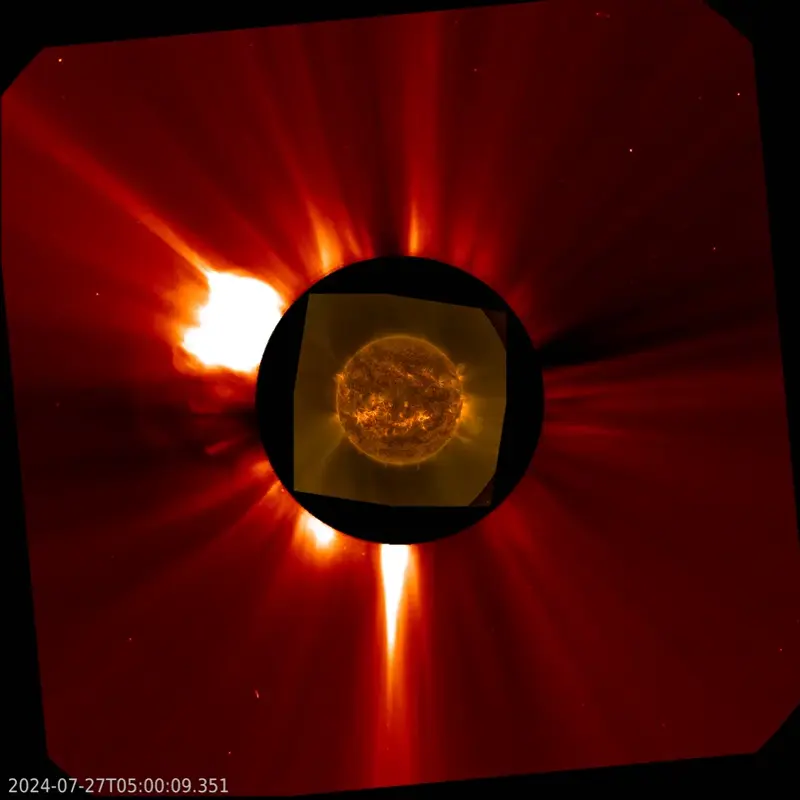
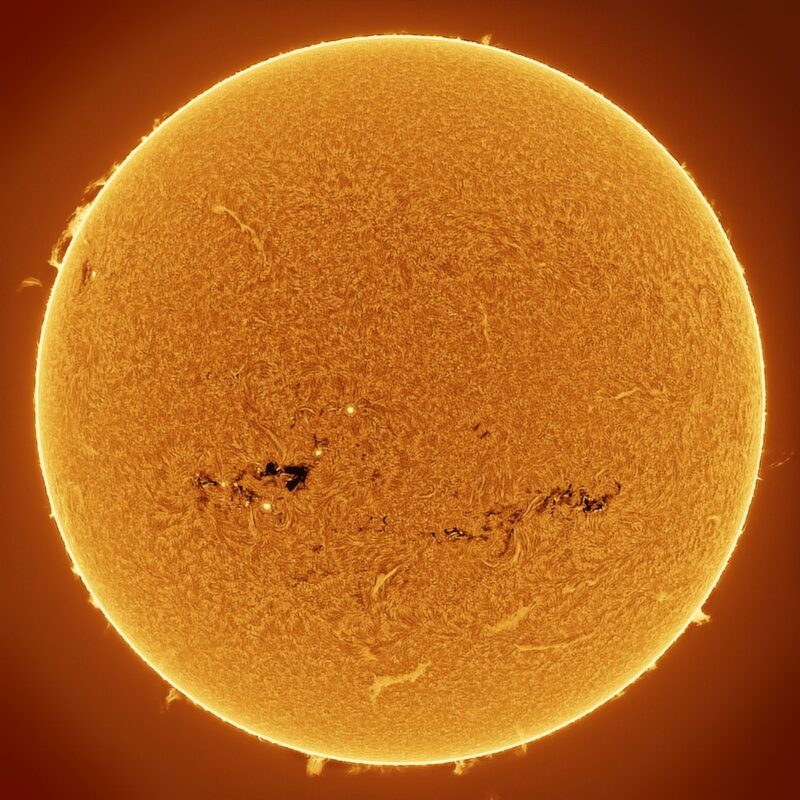
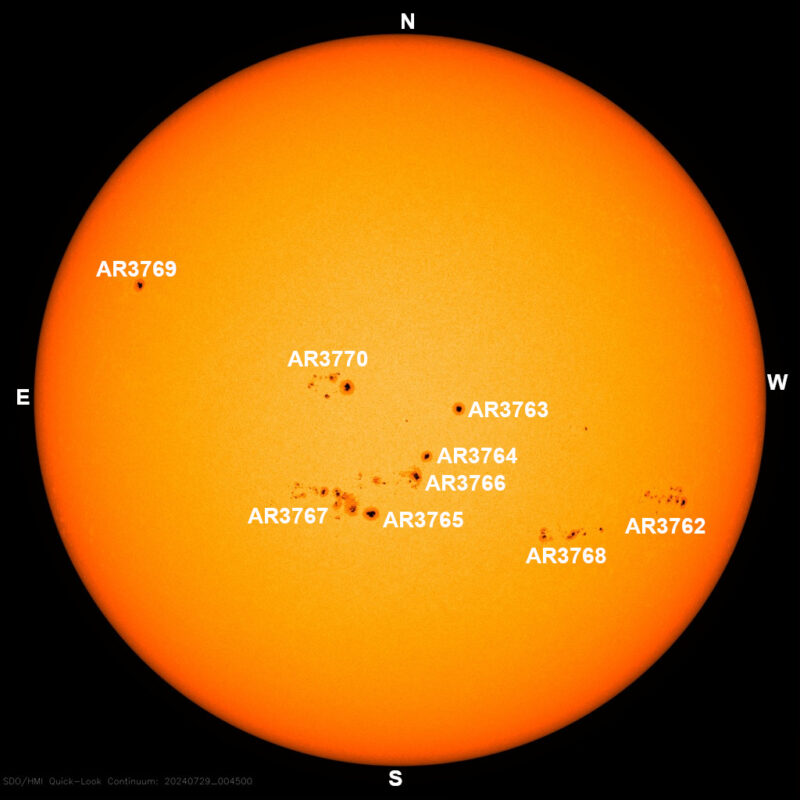
Sun news July 27: AR3751 releases gorgeous prominences
The just-departed M flare producer of the week – active region AR3751 – keeps producing flares that we’re now seeing at the very edge of the western horizon. We see them as gorgeous prominences, such as the one above captured by the GOES-16 satellite. Meanwhile, sun activity reached moderate levels with the production of three M flares fired during our observation period between 11 UTC yesterday and 11 UTC today. The largest was an M4.2 flare at 2:37 UTC on July 27. It came from AR3766, provoking an R1 (minor) radio blackout that affected an area over the Philippine Sea. Current solar activity consists of dancing, long-lasting prominences and jets all around the sun’s edge. Meanwhile, we wait for the big guys to appear. These are the producers of the X7 and X1 flares that the Solar Orbiter’s STIX X-ray telescope saw a couple of days ago on the far side of our sun. Stay with us.
Last 24 hours: Solar activity remains at moderate levels due to three M flares fired over the past day. The sun keeps giving us our daily dose of Ms. The first M of the period was the largest; it was an M4.2 flare at 2:37 UTC on July 27 by AR3766. It caused an R1 (minor) radio blackout affecting an area over the Philippine Sea. The second M was an M3.1 flare fired by active region AR3762 at 5:46 UTC on July 27. Its correspondent R1 (minor) radio blackout was over Myanmar. The third M of the period was an M2.04 flare at 10:40 UTC on July 27 by AR3762, with an R1 (minor) radio blackout over Sudan in Africa. During our observation period between 11 UTC yesterday and 11 UTC today, the sun exploded a total of 17 flares; the aforementioned three Ms plus 14 C flares. Lead flare producer of the day was sunspot region AR3762 with eight flares during the period: two Ms and six Cs. The sun currently has 10 numbered active regions. There are two newcomers. One is AR3768, a sunspot region that emerged in the south, now located close to the central meridian. And the other is active region AR3769, which came in through the northeast limb (edge). Among the 10 labeled active regions on the solar disk, sunspot region AR3762 keeps its high potential beta-gamma-delta magnetic configuration, and AR3761 has a gamma-beta complexity. The rest of the eight sunspot regions are either stable or in decay, showing either alpha or beta configurations.
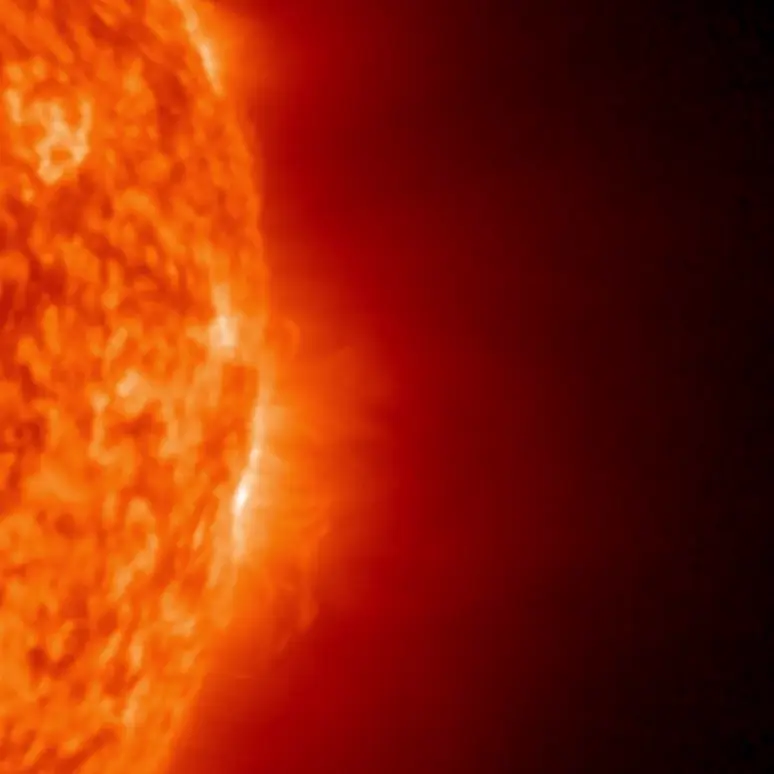

Sun news July 26: Geomagnetic storming earlier, more tonight
A coronal mass ejection (CME), or chunk of solar material, reached Earth earlier today, causing a G1 (minor) geomagnetic storm. The Kp=5 storm threshold was reached at 5:41 UTC this morning. And there’s more to come; further G1 storming is anticipated overnight with the arrival of solar material that left the sun on July 23. Aurora chasers, keep an eye out!
Last 24 hours: The Solar Orbiter’s STIX X-ray telescope, now located almost directly on the far side of our sun, has been observing some big activity. It recorded flares that might have been as large as X7 and X1. The X7 flare was what produced the halo CME we saw blasting from the far side yesterday. The regions that produced these big events will be rotating into our view in the next few days, so excitement could be on its way! Back to the Earth-facing side of the sun, solar activity remains moderate due to two M flares fired over the past day. It’s slightly surprising we’ve not seen more intense flaring, given that sunspot region AR3762 has a high potential beta-gamma-delta magnetic configuration, and a couple more regions have gamma-beta complexities. Between 11 UTC yesterday and 11 UTC today, our star released 19 flares: two Ms and 17 C flares. The first M was an M1.3 flare at 15:37 UTC on July 25 from AR3751. An R1 (minor) radio blackout was observed affecting an area over the Atlantic Ocean south of Bermuda. The second M was the largest flare of the period, an M1.7 flare at 4:42 UTC on July 26 from AR34761. It caused an R1 (minor) radio blackout over Hainan in China. The lead flare producer title for the period was AR3761 with six flares: an M and five Cs. The sun currently has nine numbered active regions, with a newcomer in the southeast: AR3767.
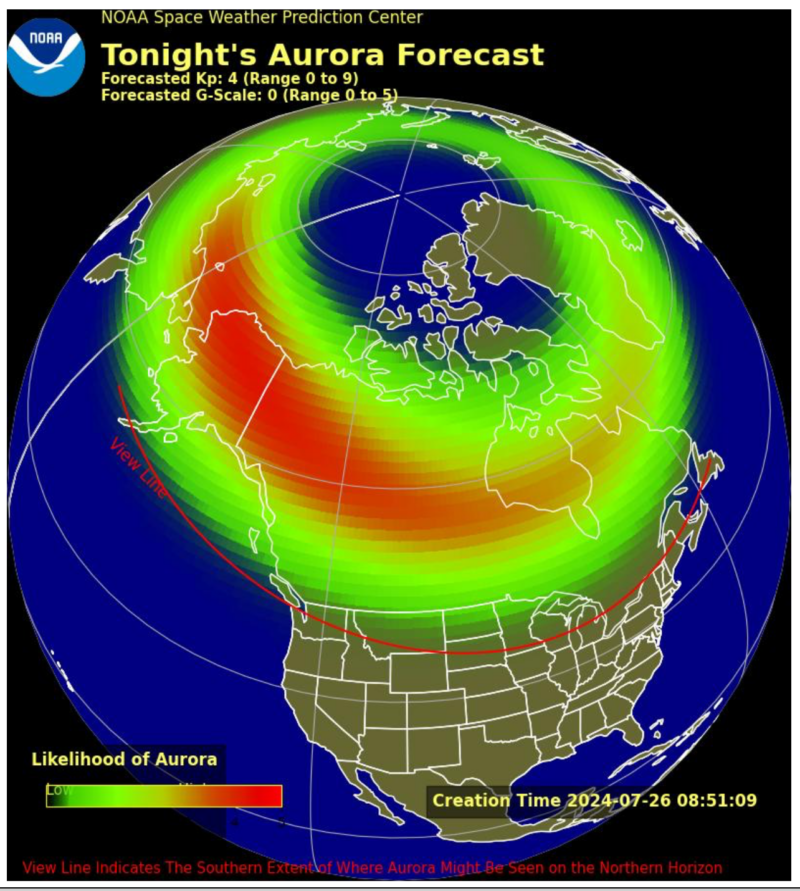

Sun news July 25: Solar deja vu, but action incoming
Welcome to solar maximum. Sometimes, during the peak of a solar cycle, we see days or even weeks of large flares and many Earth-directed coronal mass ejections (CMEs). And at other times, we have days to weeks when the sun is active but only produces moderate flaring, with few CMEs sent our way. This is where we are now! The sun today looks largely like it did yesterday, with only an M flare and a single Earth-glancing CME to report. But a high activity period could be on the way. We’re seeing lots of action coming from the sun’s far side; a few days ago, an active region produced an X17 flare, which would have been the largest recorded in the last two solar cycles if we had observed it. And just today, another halo CME and other far-sided eruptions were observed coming from the far side. These regions will soon rotate into view. So could we be in for a spell of major activity? Stay tuned.
Last 24 hours: During the past day, solar activity remained moderate after an isolated M flare. However, flaring production increased: between 11 UTC yesterday and 11 UTC today our star released 19 flares (an M and 18 C flares), compared to seven the day before. The largest flare of the past day was an M3.0 flare at 17:21 UTC on July 24 from active region AR3751. An R1 (minor) radio blackout was observed affecting an area over the United States. Active region AR3762 kept its beta-gamma-delta magnetic configuration, meaning it has a higher potential for M and X flares. The focal region of the week, AR3751, is now located at the very edge of the solar limb (edge) in the southwest. The region has lost its delta configuration, and now has a lower potential beta-gamma configuration. However, its location on the limb makes it difficult to analyze. The lead flare producer of the period was AR3762, which blasted out eight C flares. The sun currently has 10 numbered active regions, with a newcomer in the southeast: AR3766.
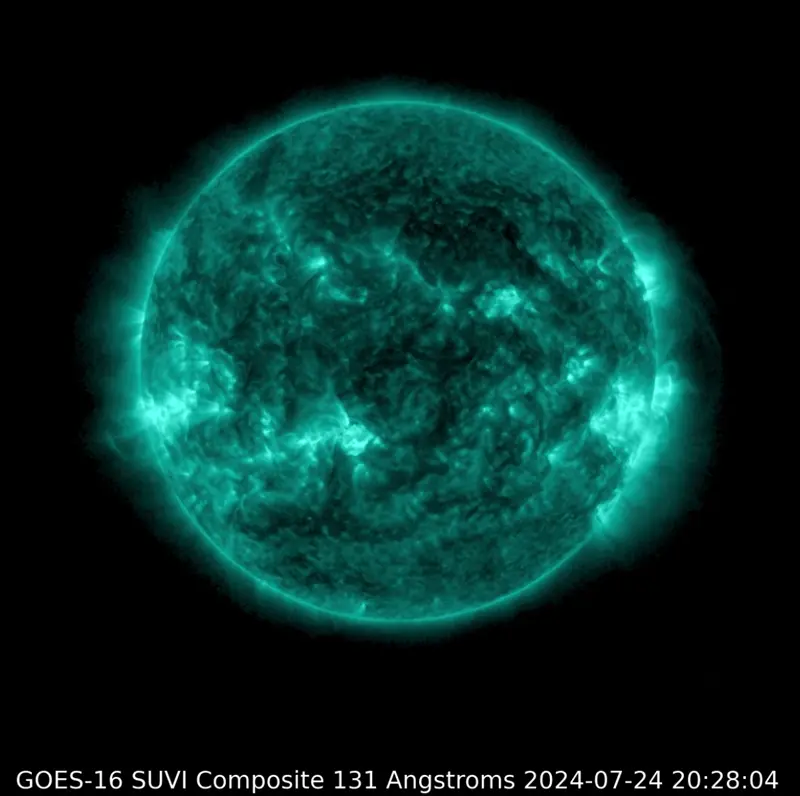
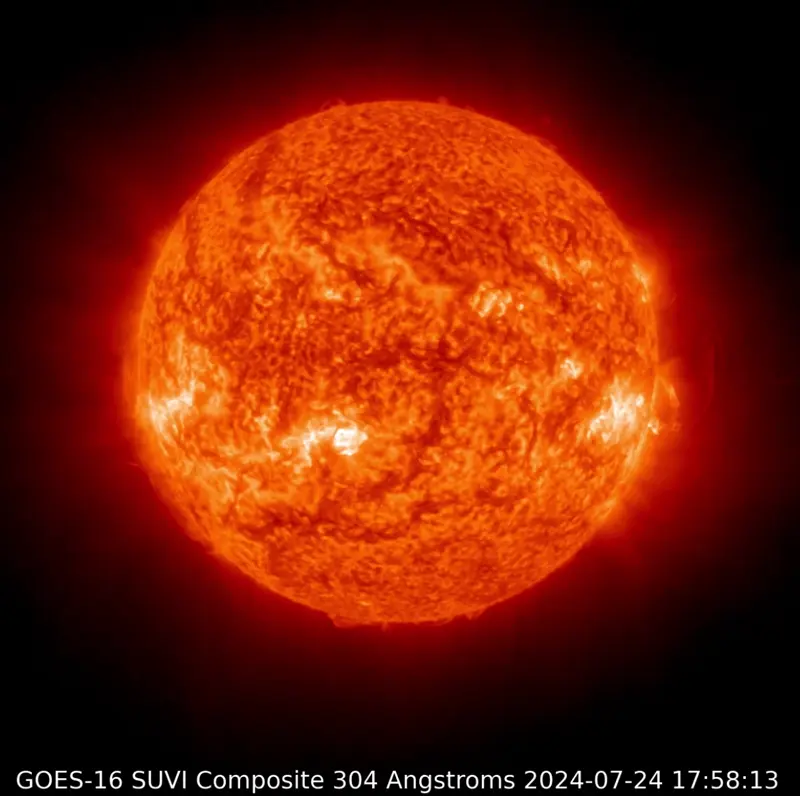
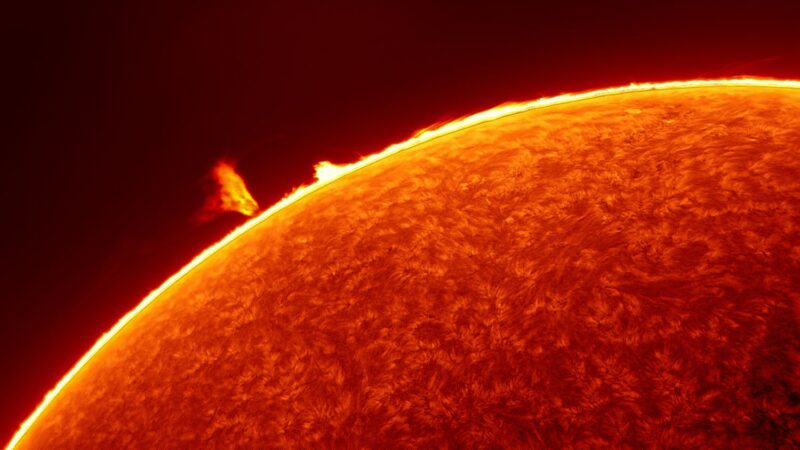
Sun news July 24: Sun activity moderate with two M flares
Sun activity is now moderate, with the production of two M flares over the past day. The proton storm from yesterday’s huge far-side eruption continues, but it has begun to subside. The weak halo coronal mass ejection (CME) from July 21 has reached Earth, but no obvious magnetic disturbance has been observed.
Last 24 hours: Overall, today’s sun activity remains moderate, but two regions have a beta-gamma-delta magnetic configuration, meaning they have a higher potential for M and X flares. So even another average day on an active star could become more exciting at any moment. Meanwhile, between 11 UTC yesterday and 11 UTC today, the sun produced two M flares and seven C flares. The largest flare was an M3.6 flare from active region AR3751 at 7:42 UTC on July 24. An R1 (minor) radio blackout affected area over the northeast of India. The second M flare of the period was an M2.5 flare from AR3765 on July 23 at 14:28 UTC. The corresponding R1 (minor) radio blackout affected an area over the middle of the Atlantic Ocean. The lead flare producer of the period was sunspot region AR3751, with an M flare and three Cs. AR3765 and AR3762 had two flares each. Active regions AR3751 and AR3762 kept their beta-gamma-delta magnetic complexity. Sunspot AR3761 kept its beta-gamma. The remaining regions have simple alpha or beta magnetic complexity. The sun has nine numbered active regions. There is a newcomer in the southeast, AR3765.
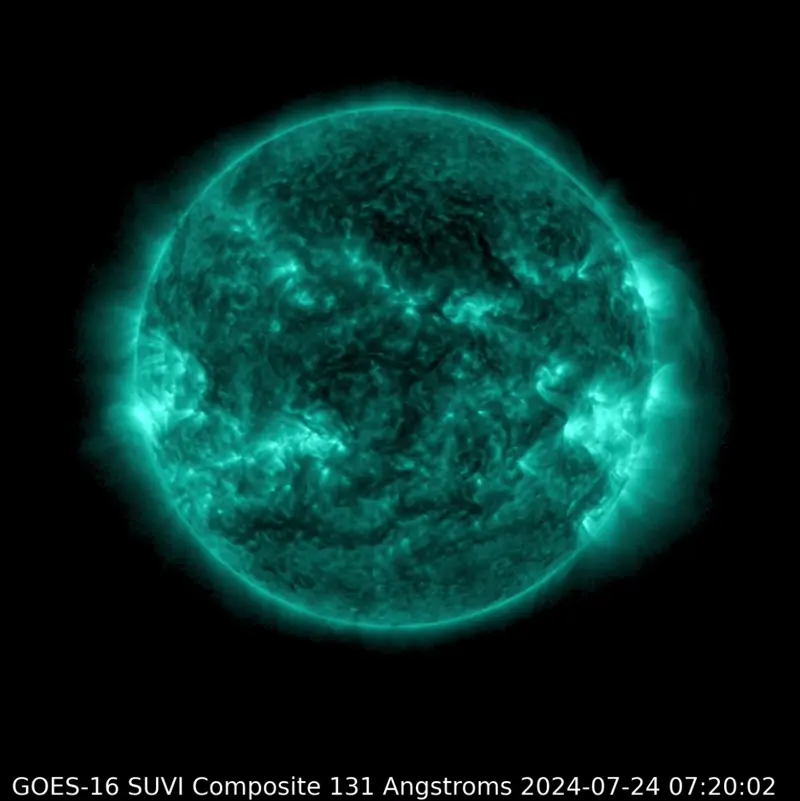
Sun news July 23: An X14 flare on sun’s far side this morning?
Something big and powerful is causing a ruckus on the sun’s far side. Around 0 UTC this morning (July 23), a large farside eruption caused a huge halo CME (see the image above). That’s when a coronal mass ejection (CME) is situated on the sun so that an expanding cloud of solar material and magnetic fields looms larger and larger, forming a “halo” around our star as seen from Earth. And experts are now estimating that this particular event might have started with an X14 flare! Halo CMEs often mean there’s a CME headed toward Earth. This CME is not headed our way, but, if it had been, it night have caused a dazzling (and perhaps scary) geomagnetic event, such as the one of October 28, 2003. And the event did accelerate high-energy protons that did reach Earth this morning. Particles from the sun’s far side, just over the sun’s western limb (edge), can travel back around to the Earth-facing side of the sun. The STIX X-ray monitor on the Solar Orbiter spacecraft observed the event that resulted from this halo eruption. STIX measured the X-ray flux and estimated the associated flare to be an X14. We await any additional data that might inform us of the speed of the eruption, but – to say the least – the incoming protons indicated it was a quite substantial eruption. If it had been Earth-directed (which it’s not), it would have caused severe to extreme geomagnetic activity. Meanwhile, the coronal mass ejection (dark fan-like filament eruption) we reported yesterday did stem from a CME that’s now headed our way. It could bring up to a G2 (moderate) geomagnetic storm and auroras tomorrow.
Last 24 hours: In the past day, solar activity has been moderate, with one M flare. Between 11 UTC yesterday and 11 UTC today, we saw solar activity on the sun’s near side reduce from 31 flares yesterday to nine flares today: an M flare and eight C flares. The largest flare was an M1.5 on July 22 at 13 UTC from AR3744. An R1 (minor) radio blackout affected an area over the Atlantic Ocean off the west coast of Africa. Following this M flare, another flare that narrowly missed becoming an M (C9.0) came from AR3762 at 15:26 UTC on July 22. The lead flare producer of the period was sunspot region AR3762 with three flares. Today the sun has two active regions showing a beta-gamma-delta magnetic complexity: AR3751 and AR3762. Sunspot AR3761 kept its magnetic complexity at a beta-gamma level. The southwest quadrant has the two largest sunspot regions in size. The remaining regions have simple alpha or beta magnetic complexity. The sun has nine numbered active regions.

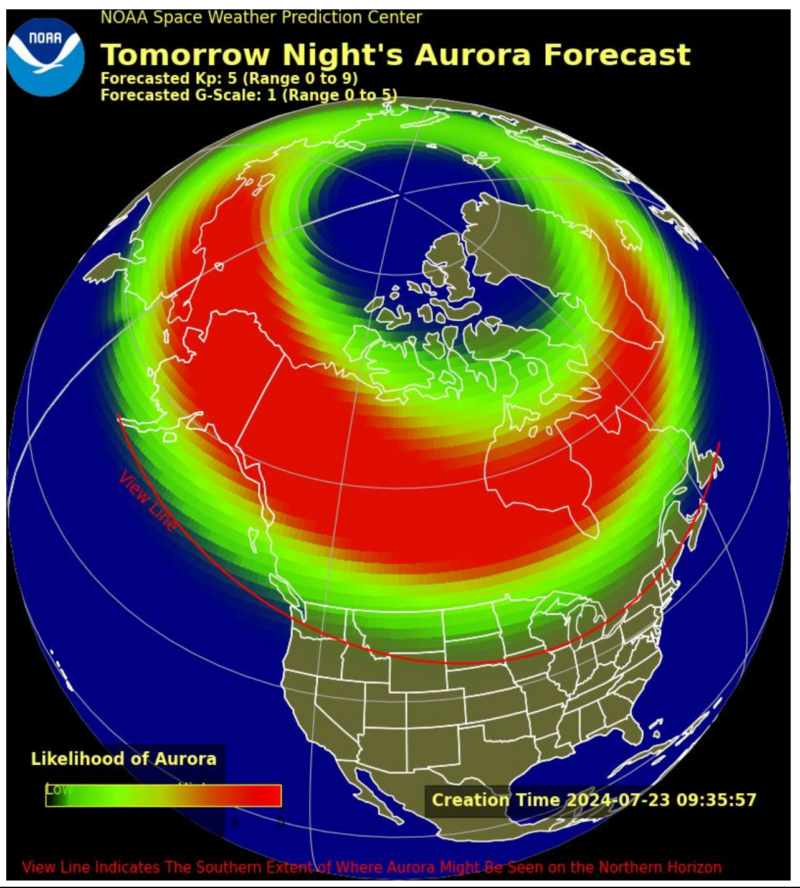
Sun news July 22: See a spray of dark plasma
Maybe you know that sunspots appear dark on the sun’s surface because they are relatively cool? If you could remove dark sunspots from the blazingly hot sun, they’d be seen to shine brightly. Likewise, the blast of solar plasma that left the sun around 16 UTC yesterday (July 21) was a relatively “chilly” (20,000 degrees C or 36,000 F) compared to the “warm” (80,000 degrees C or 144,000 F) solar atmosphere behind it. So it looked dark. It happened when a filament sitting across sunspot region AR3757 erupted, producing an M1 flare and the dark fanlike jet of cool sun stuff, which shot northward. Interesting to see!
Last 24 hours: Solar activity in the past day continued at moderate levels with the production of six M flares. During our observation period (11 UTC yesterday to 11 UTC today), our sun produced 31 flares: the six M flares and 25 C flares. The largest flare was an M4.0 on July 22 at 03:55 UTC from AR3762. An R1 (minor) radio blackout affected an area over eastern Asia. The lead flare producer was sunspot region AR3751, with 12 flares. It produced three M flares and nine C flares. The breakdown of M flares is:
• M1.0 on July 22 at 16:18 UTC from AR3757. R1 (minor) radio blackout over the Americas.
• M3.2 on July 21 at 23:21 UTC from AR3744. R1 (minor) radio blackout over the Pacific Ocean.
• M1.4 on July 22 at 03:27 UTC from AR3762. R1 (minor) radio blackout over eastern Asia.
• M4.0 on July 22 at 03:55 UTC from AR3762. R1 (minor) radio blackout over eastern Asia.
• M1.9 on July 22 at 04:14 UTC from AR3762. R1 (minor) radio blackout over eastern Asia.
• M1.5 on July 22 at 09:31 UTC from AR3744. R1 (minor) radio blackout over the Middle East.
Active region AR3751 kept its beta-gamma magnetic complexity. The greater the magnetic complexity, the greater the potential for strong flaring. AR3751 is no longer the largest active region on the sun’s visible face. AR3761 maintained its beta-gamma complexity and is now the largest region on the disk. The remaining regions have simple alpha or beta magnetic complexity. The sun has nine numbered active regions. A filament erupted northward from AR3757 around 16 UTC on July 21, creating a dark fan-like spray structure because the solar plasma was cooler than the background sun. A coronal mass ejection (CME) was observed in SOHO LASCO around 16:48 UTC. The event is under analysis to determine any Earth-directed component.
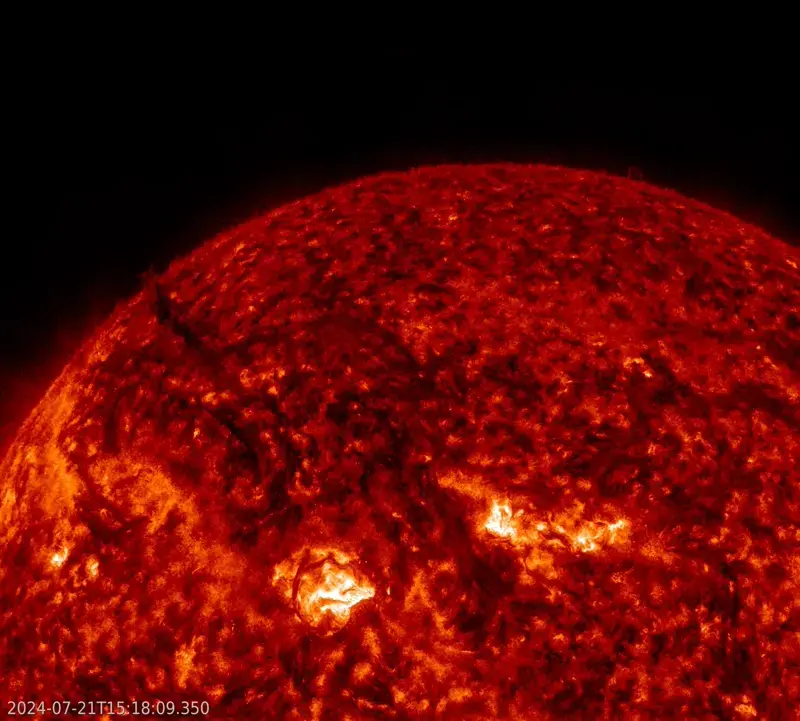
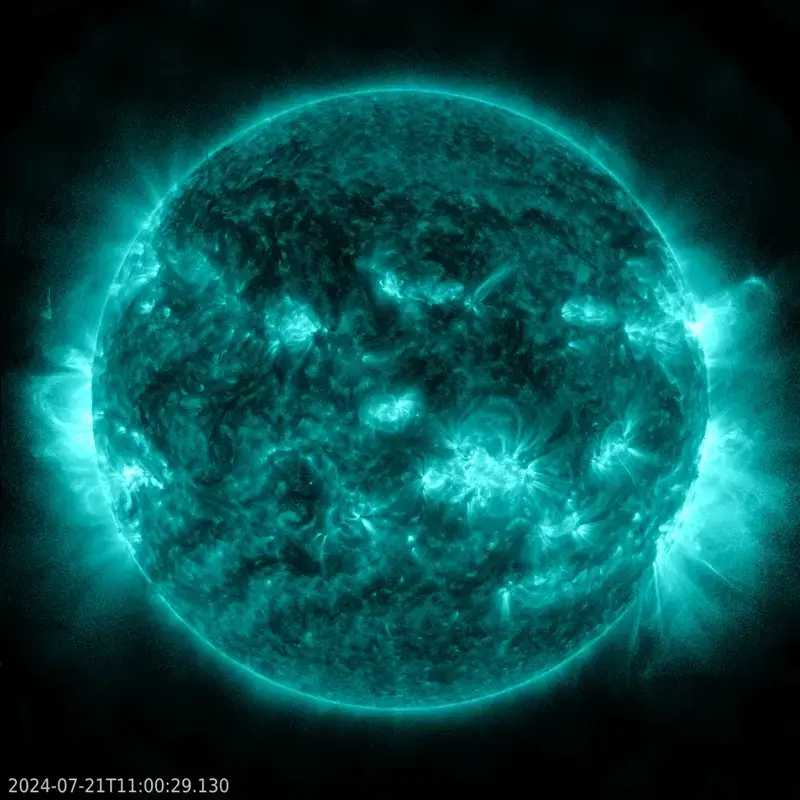
Sun news July 21: Here’s an average day on an active sun
Happy SUNday! It’s an average day on our active sun, now at or near Solar Maximum, the peak of the 11-year sunspot cycle. Flaring levels have been moderate over the past day, with three M flares. The disk and limb (edge) are covered with prominences and filaments. A few have erupted, but none of them are Earth-directed. Even with this “ordinary” day, looking at the sun in 304- and 171-angstrom light from the sun-observing GOES-16 and SDO spacecraft, the signs of Solar Maximum are all around (see the image below). We can see huge magnetic loops off the limb (edge) indicative of powerful magnetic fields from sunspots. Small flashes all over the disk illuminate solar flares from small to moderate sizes (C and M flares, respectively.) Bright areas on the solar disk show active regions—the superhot coronal atmosphere sitting overtop of sunspots. And we’re currently in a SDO “Earth eclipse” season, so we’re also seeing quick moments of darkness due to Earth’s moving temporarily between SDO and the sun. Our favorite star always amazes!
Last 24 hours: Solar activity in the past day continued at moderate levels with the production of three M flares. During our observation period (11 UTC yesterday to 11 UTC today), our sun produced 23 flares: the three M flares and 20 C flares. The largest flare was an M1.6 on July 20 at 18:36 UTC from AR3744. An R1 (minor) radio blackout affected an area over the United States. The lead flare producer was sunspot region AR3751, with eleven flares. It produced one of the M flares and ten C flares. The breakdown of M flares is:
• M1.6 on July 20 at 18:36 UTC from AR3744. R1 (minor) radio blackout over the United States.
• M1.0 on July 21 at 03:46 UTC from AR3744. R1 (minor) radio blackout over Eastern Asia.
• M1.8 on July 21 at 08:26 UTC from AR3751. R1 (minor) radio blackout over the Middle East.
Active region AR3751 kept its beta-gamma magnetic complexity. The greater the magnetic complexity, the greater the potential for strong flaring. AR3751 remains the largest active region on the sun’s visible face. AR3761 increased its complexity to beta-gamma. The remaining regions have simple alpha or beta magnetic complexity. The sun has 12 numbered active regions. A small filament erupted from the northeast around 15:00 UTC on July 20 and another filament lifted off from the north pole around 17 UTC on July 20. Neither created an Earth-directed CME.

Sun news July 20: Huge blob of sun stuff erupts
A huge filament erupted from the sun at around 18 UTC on July 19. The eruption hurled a massive amount of solar stuff into space. The eruption occurred south of AR3751 and just after the M2 flare from the region. Solar activity remains at moderate levels with the production of three M flares. The number of sunspot regions decreased from the record number of 18 yesterday to only 13 today. Stay tuned for more sun news.
Last 24 hours: Solar activity in the past day continued at moderate levels with the production of three M flares. During our observation period (11 UTC yesterday to 11 UTC today), our sun produced 15 flares: the three M flares and 12 C flares. The largest flare was an M2.0 on July 19 at 18:06 UTC from AR3751. An R1 (minor) radio blackout affected an area over Campeche in Mexico. The lead flare producer was sunspot region AR3751, with seven flares. It produced two of the M flares of the period plus five C flares. The breakdown of M flares is:
• M2.0 on July 19 at 18:06 UTC from AR3751. R1 (minor) radio blackout over Campeche in Mexico.
• M1.0 on July 19 at 22:51 UTC from AR3758. R1 (minor) radio blackout over the Pacific Ocean off the west coast of Hawaii.
• M1.8 on July 20 at 07:20 UTC from AR3751. R1 (minor) radio blackout off the west coast of India.
Active region AR3751 kept its beta-gamma magnetic complexities. The greater the magnetic complexity, the greater the potential for strong flaring. AR3751 is also the largest active region on the sun’s visible face. The rest of the regions have simpler alpha or beta magnetic complexities. The sun has 13 numbered active regions.


Sun news July 19: Most sunspots of Solar Cycle 25 so far!
Big news on the sun today. Our star now has 18 numbered sunspot regions, the largest number of regions of Solar Cycle 25 so far. Yesterday we saw an impressive 17 sunspot regions on the sun’s face, which matched the previous record for sunspot number, seen in April 2024. May 2024 had the highest monthly average sunspot number of the solar cycle, 171.7. And today we have the most visible spots on the sun’s face for a single day. Surely, the peak of Solar Cycle 25 is near, or here! Stay tuned for more sun news.
Last 24 hours: An isolated M flare kept sun activity at moderate during the last 24 hours (11 UTC yesterday to 11 UTC today). Our star produced a total of 12 flares: an M flare and 11 C flares. The largest flare was an M3.2 flare earlier today, at 8:23 UTC on July 19, from AR3753. It caused an R1 (minor) radio blackout over Oman. The lead flare producer of the period was sunspot region AR3751 with six C flares. Active regions AR3743 and AR3751 have beta-gamma magnetic complexities. The greater the magnetic complexity, the greater the potential for strong flaring. AR3751 is now the largest active region on the sun’s visible face. The remaining regions have simpler alpha or beta magnetic complexities. The sun has 18 numbered active regions today, the largest number for Solar Cycle 25 so far. The disk has a single newcomer: AR3760.
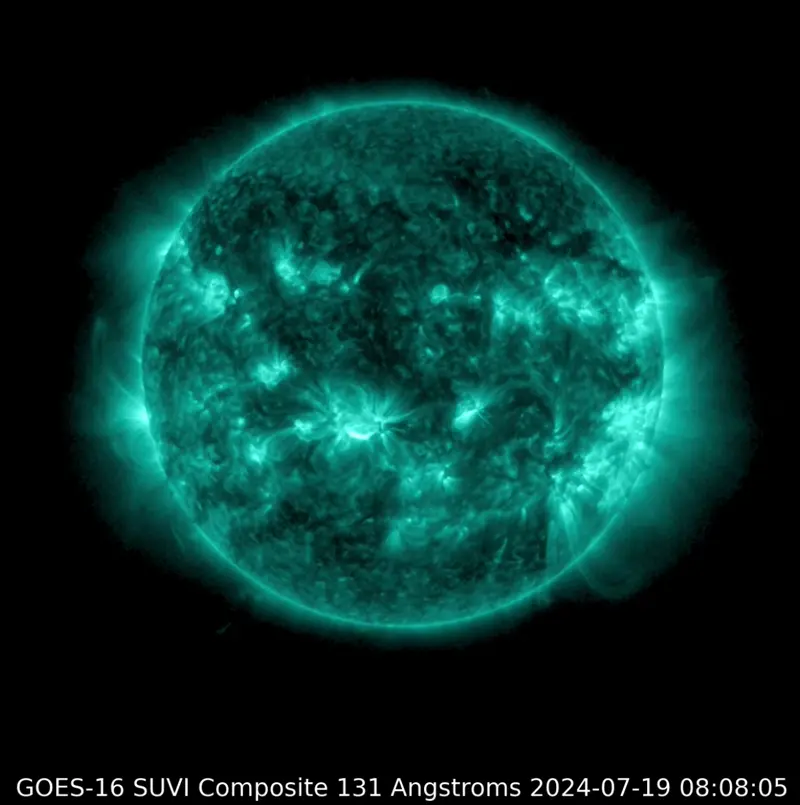
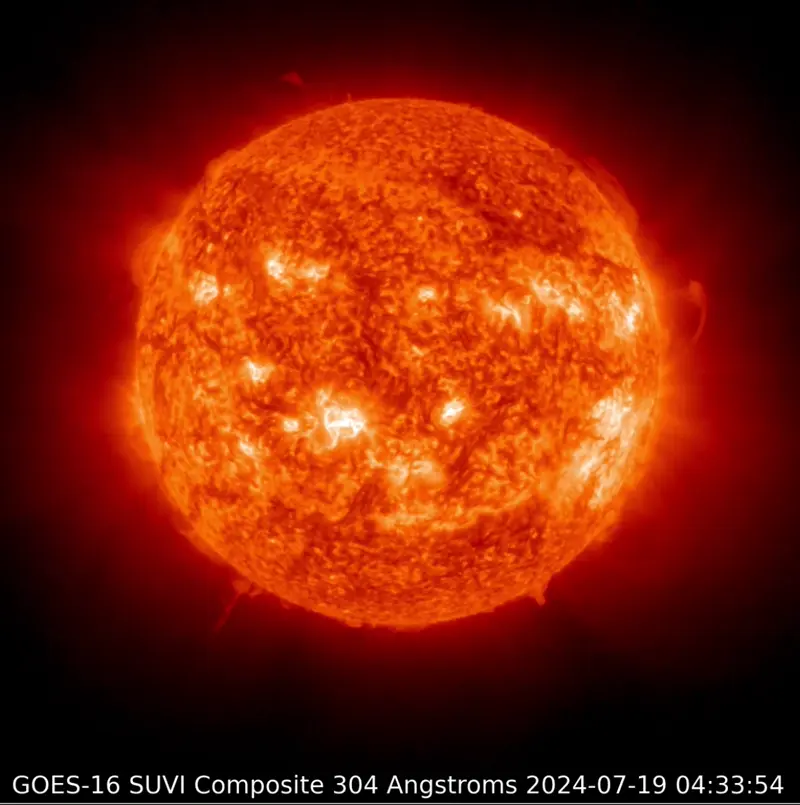
Sun news July 18: Huge prominence, sunspot groups everywhere
Wow! A stunning, incredibly long prominence erupted from the sun’s southeast limb (edge) last night. This rope of solar material and magnetic fields extended more than 500,000 km (310,000 mi) from the solar surface. The rest of the sun couldn’t live up to this excitement, with four small M flares over the past day failing to live up to the previous day’s X flare. But our star currently has an impressive 17 sunspot regions on its Earth-facing side – the joint-most we’ve seen in Solar Cycle 25 so far – so it’s primed for more activity!
Last 24 hours: Sun activity has dropped to moderate, with four M flares. Between 11 UTC yesterday and 11 UTC today, the sun produced 20 flares: four M flares and 16 C flares. Two of the M flares came from AR3753; the first was an M1.2 flare on July 17 at 19:51 UTC, and the second an M2 shortly after at 19:58 UTC. Each of the first two flares caused an R1 (minor) radio blackout over the Pacific Ocean off the west coast of Baja in Mexico. The largest flare of the period was an M2.2 flare on July 18 at 10:04 UTC from AR3751. It produced an R1 (minor) radio blackout over Africa. Just after that, at 10:27 UTC, this same sunspot produced its second M flare of the period, an M2.0. The lead flare producer of the period was AR3751, which blasted out 11 flares: two Ms and nine Cs. Sunspot region AR3738 just rotated over the southwest limb (edge). It is estimated to still have a beta-gamma-delta magnetic complexity with potential for more M flares and even another X flare. Active regions AR3743 and AR3751 show beta-gamma configurations, and AR3751 is now the largest active region on the sun. The sun has 17 numbered active regions, the largest amount yet during Solar Cycle 25, including two newcomers: AR3758 and AR3759.
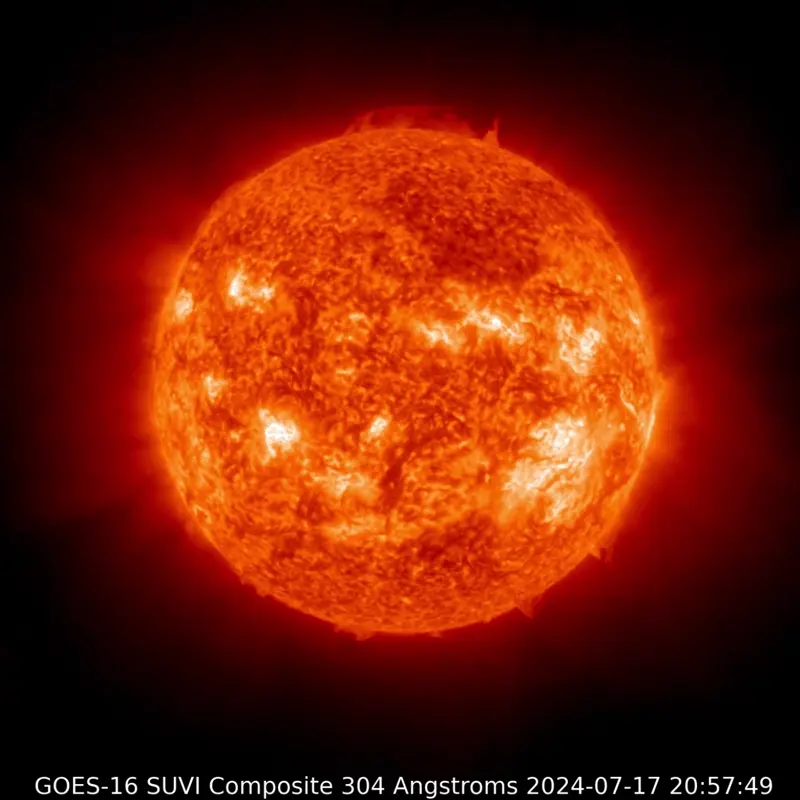
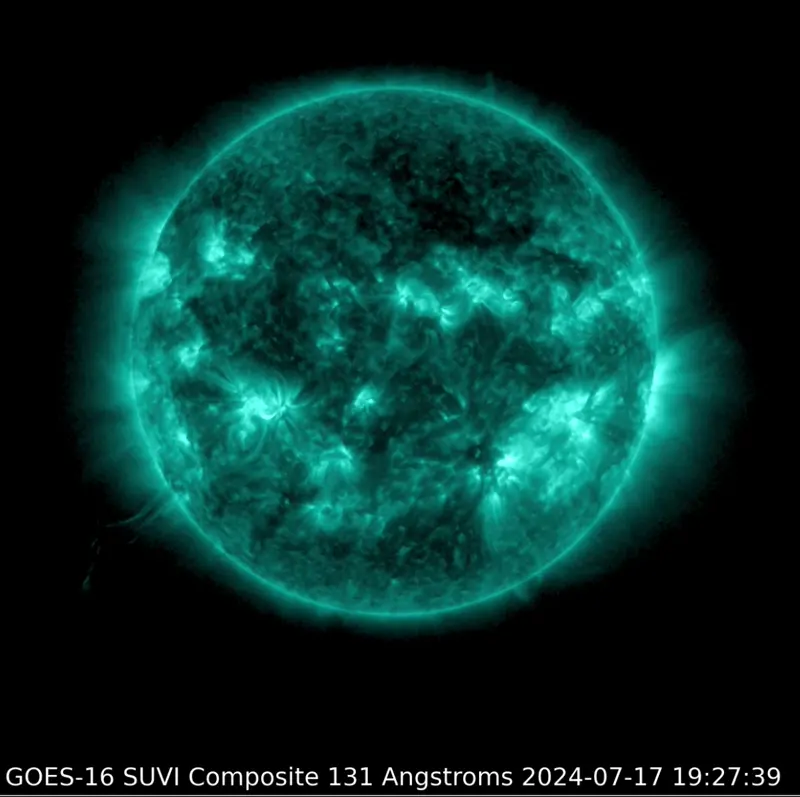
Sun news July 17: AR3738 fires an X flare!
BAM, X flare! Just as it approached the western limb (edge) to begin passing out of view, AR3738 blasted an X1.9 flare yesterday afternoon. The eruption sent out a bubble of sun-stuff – a coronal mass ejection (CME) – toward the west. It doesn’t look like this is heading toward Earth, but we’ll wait to hear from the space weather analysts. Does AR3738 have any more big eruptions in store from us, even from over the solar horizon? The chance for X flares is 25% today, so let’s see!
Last 24 hours: Sun activity is high after the X flare. In the past 24 hours the sun produced 14 flares: an X flare, four M flares, and nine C flares. The largest flare produced between 11 UTC yesterday and 11 UTC today was the X1.9 flare from AR3738 at 13:26 UTC on July 16. An R3 (strong) radio blackout affected an area over the Atlantic Ocean. AR3743 was the lead flare producer of the period, with two C flares and two of the M flares. Here are the X and M flares of the period:
• X1.9 on July 16 at 13:26 UTC from AR3738 – R3 (strong) radio blackout over the Atlantic Ocean.
• M1.6 – July 16, 21:24 UTC from AR3753 – R1 (minor) radio blackout over the Pacific Ocean off the east coast of Hawaii.
• M1.9 – July 16, 22:06 UTC from AR3744 – R1 (minor) radio blackout over Hawaii.
• M5.1 – July 17, 06:39 UTC from AR3743 – R1 (minor) radio blackout over northeast India.
• M3.4 – July 17, 07:08 UTC from AR3743 – R1 (minor) radio blackout over northwest India.
Just after releasing an X flare, AR3738 rotated over the southwest limb (edge). It is estimated to still have its high-potential beta-gamma-delta magnetic complexity. AR3751 kept its beta-gamma configuration, and is now the largest active region on the Earth-facing side of the sun. The sun has 15 numbered active regions, including three newcomers: AR3755, AR3756 and AR3757.

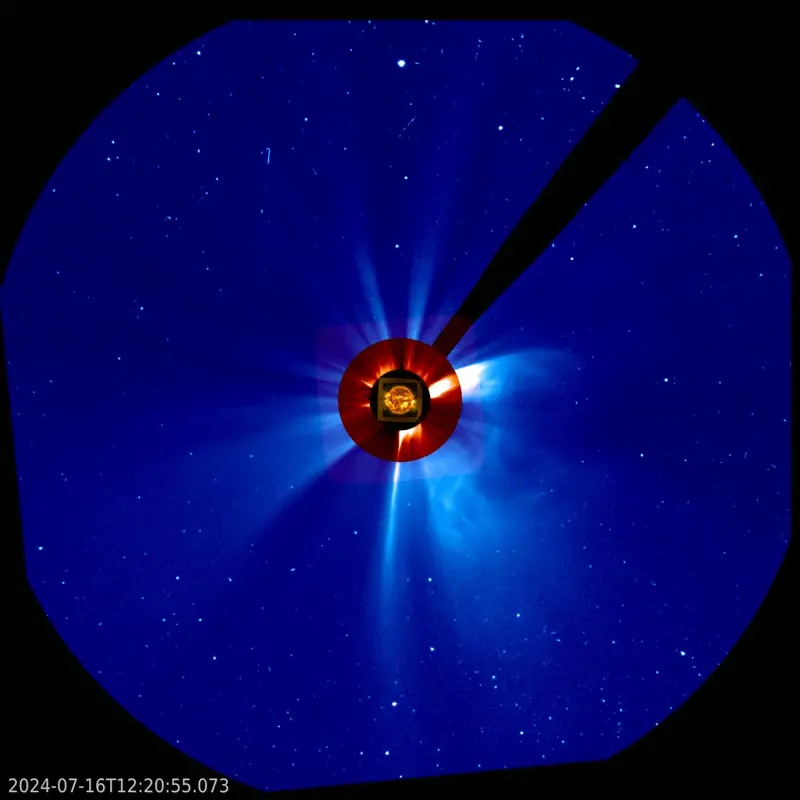
Sun news July 16: See this solar plasma jet from the sun
A beautiful jet and large coronal hole caught our attention earlier today. The sun sprayed solar plasma off its eastern limb. See the image above. Meanwhile, solar wind from the coronal hole in the sun’s northern hemisphere on its central meridian should disturb Earth’s magnetic field beginning on July 17. See more about that under “current geomagnetic activity,” below.
Last 24 hours: Solar activity has continued at moderate levels in the past 24 hours, with two M flares. The largest flare of the observation period happened between 11 UTC yesterday and 11 UTC today. It was an M3 flare at 7:37 UTC on July 16. An R1 (minor) radio blackout affected an area over Pakistan. The sun released 12 flares, two M flares, and 10 C flares. AR3751 is the lead flare producer of the period. It produced four C flares. This is the breakdown of the M flares of the period:
• M1.4 on July 16 at 03:01 UTC from AR3744 with an R1 (minor) radio blackout over the Philippine Sea.
• M3.6 on July 16 at 7:37 UTC from AR3753 with an R1 (minor) radio blackout over Pakistan.
AR3738 kept its beta-gamma-delta magnetic complexity. After the region’s X flare and large M flares earlier this week, its flare production was low, as it prepares to leave the building, that is, rotate over the sun’s western limb (edge). Meanwhile, AR3751 developed a beta-gamma configuration. A new coronal hole emerged, now located centrally in the sun’s north hemisphere. The sun has 12 numbered active regions. There are two newcomers: AR3753 and AR3754.



Sun news July 15: SDO eclipse season begins today
Interesting sun news today! The Solar Dynamics Observatory (SDO) enters its 29th eclipse season. The spacecraft’s inclined geosynchronous orbit around Earth is designed to maximize its time looking at the sun. Still, each year, the spacecraft must experience two periods – lasting 3–4 weeks each – where Earth blocks the sun periodically from the spacecraft’s point of view. The eclipses start at around 30 minutes in length, reach a peak length of about 72 minutes, then decrease again. This sequence will end on August 11 with eclipses down to 30 minutes again. After this, the next SDO eclipse season, #30, will begin on January 10, 2025.
Last 24 hours: In other sun news, solar activity has decreased from high to moderate in the past 24 hours, with M flares. The largest flare of the observation period occurred between 11 UTC yesterday and 11 UTC today, was an M2.7 flare at 9:54 UTC on July 15. The sun released 23 flares, four M flares, and 19 C flares. AR3738 produced the four M flares and 13 C flares. The M flares produced regional radio blackouts. The M flares during the past observation period are:
• M1.0 on July 14 at 21:03 UTC from AR3738 with an R1 radio blackout
• M1.3 on July 15 at 03:55 UTC from AR3738 with an R1 radio blackout
• M2.7 on July 15 at 09:54 UTC from AR3738 with an R1 radio blackout
• M1.9 on July 15 at 10:19 UTC from AR3738 with an R1 radio blackout
AR3738 has maintained its beta-gamma-delta magnetic complexity. Given the region’s X flare and large M flares in the previous 24-hour observation period, the chance for more large flares is high. The sun has 12 numbered active regions. There is one newcomer: AR3852.

Sun news July 14: BAM! X flare
X flare! AR3738 has been batting below its average until the last 24 hours. It started to pick up its flaring at the end of July 13, with several M flares, including two M5+ flares. Then, early on July 14, BAM! The region released an X1.3 flare. No obvious coronal mass ejections (CMEs) were observed in the available imagery, but regions across Earth experienced shortwave radio blackouts that lasted from a few minutes (from small M flares) up to 30 minutes during the X flare. By the way … happy Bastille Day! Today’s X flare isn’t the first time we’ve recorded Bastille Day fireworks. On July 14, 2000, 24 years ago, the sun released a now-famous eruption. A sunspot region sitting near disk center released a monumental blast. While only releasing an X5.7 flare, the particle storm and CME released were ones for the record books. Learn more about the spectacular day here: The Bastille Day Flare.
Last 24 hours: Solar activity surged to high in the past day, first with the release of two M5+ flares from AR3738 on July 13, several other smaller M flares on July 13–14, and then an X1.5 flare from AR3738 on July 14. Since yesterday, the region has increased in magnetic complexity from beta-gamma to beta-gamma-delta. Its size has grown to 6.5 times the surface area of Earth. AR3738 produced 14 of 24 flares, including eight of nine M flares and an X flare. The largest flare of the observation period occurred between 11 UTC yesterday and 11 UTC today; there was an X1.3 flare at 2:23 UTC on July 14. The M and X flares during the past observation period are:
• M5.3 on July 13 at 12:21 UTC from AR3738 with an R2 radio blackout
• M1.8 on July 13 at 14:59 UTC from AR3745 with an R1 radio blackout
• M2.0 on July 13 at 15:41 UTC from AR3738 with an R1 radio blackout
• M1.0 on July 13 at 19:25 UTC from AR3738 with an R1 radio blackout
• M5.0 on July 13 at 22:44 UTC from AR3738 with an R2 radio blackout
• M2.7 on July 13 at 23:14 UTC from AR3738 with an R1 radio blackout
• M1.7 on July 14 at 01:05 UTC from AR3738 with an R1 radio blackout
• X1.3 on July 14 at 02:23 UTC from AR3738 with an R3 radio blackout
• M1.0 on July 14 at 03:46 UTC from AR3751 with an R1 radio blackout
• M3.0 on July 14 at 04:05 UTC from AR3738 with an R1 radio blackout
• M1.0 on July 14 at 10:16 UTC from AR3738 with an R1 radio blackout
The sun has 11 numbered active regions. There are three newcomers: AR3749, AR3850, and AR3851.
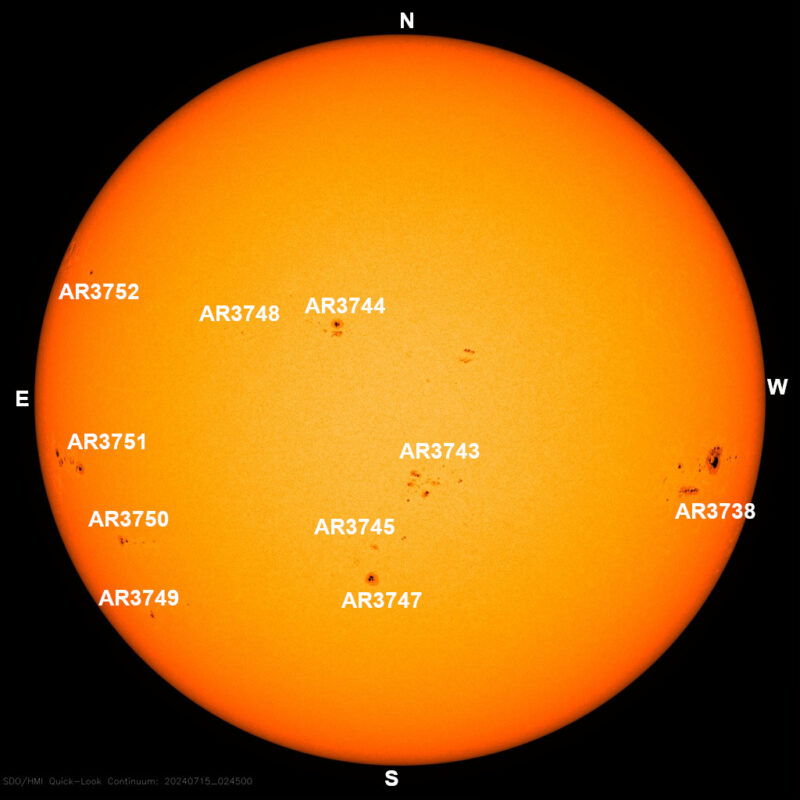
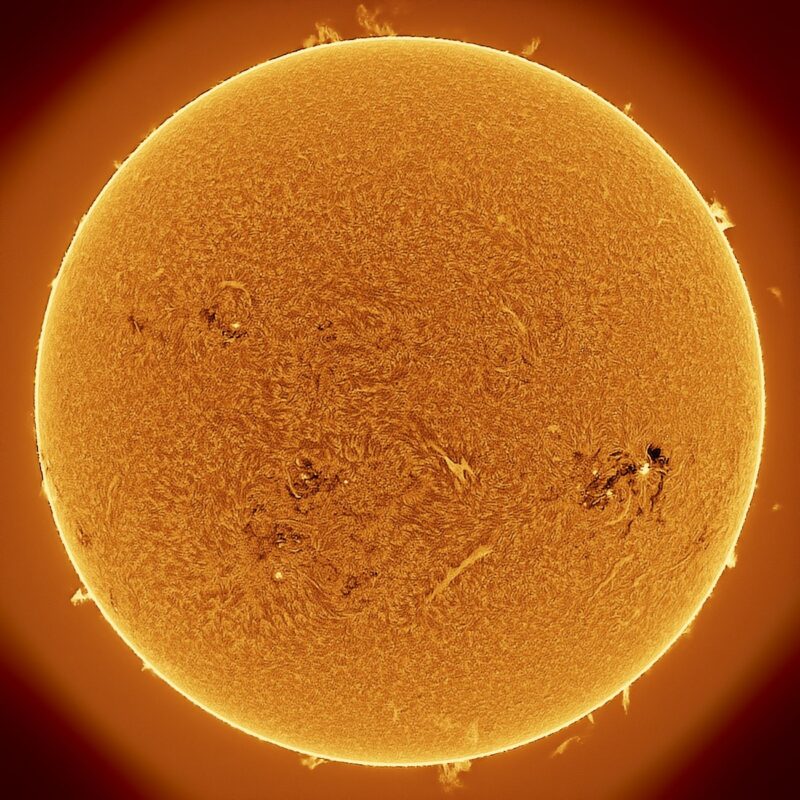
Sun news July 13: Magnetic storm at Earth, M flare on the sun
We’re awaiting a possible G1 (minor) geomagnetic storm due to high-speed solar wind from a coronal hole. Sun activity increased to moderate with an M1.4 flare over the past day. The M flare came from an unnumbered active region in the southwest. The flare did not come from AR3738, which is what we might have expected. But the region is still the largest and most magnetically complex region on the disk currently. Most of the activity is still focused on the solar limb (edge). Prominences are dancing all around with many filaments on the solar disk. These filaments could provide additional action in the upcoming days. Aurora watchers, keep an eye out for the northern and southern lights later today.
Last 24 hours: Solar activity reached a moderate level due to the production of an isolated M1.4 flare. Over the past day, between 11 UTC yesterday and 11 UTC today, our observation period, the sun produced 13 flares, one M flare and 12 C flares. Three active regions on the Earth-facing side of our sun share the position of lead flare producers, with three flares each. These active regions are AR3738, AR3740, and an unnumbered active region in the southeast. The largest flare of the day was the M1.4 flare by an as-yet-unnumbered active region in the southwest at 3:18 UTC on July 13. The flare caused an R1 (minor) radio blackout over the Philippine Sea. AR3738 remains the largest and most complex region of the period. It still has a beta-gamma configuration, while AR3743 lost its gamma and now shows a simple beta configuration. The sun has eight numbered active regions. There is a newcomer in the northeast, AR3748.
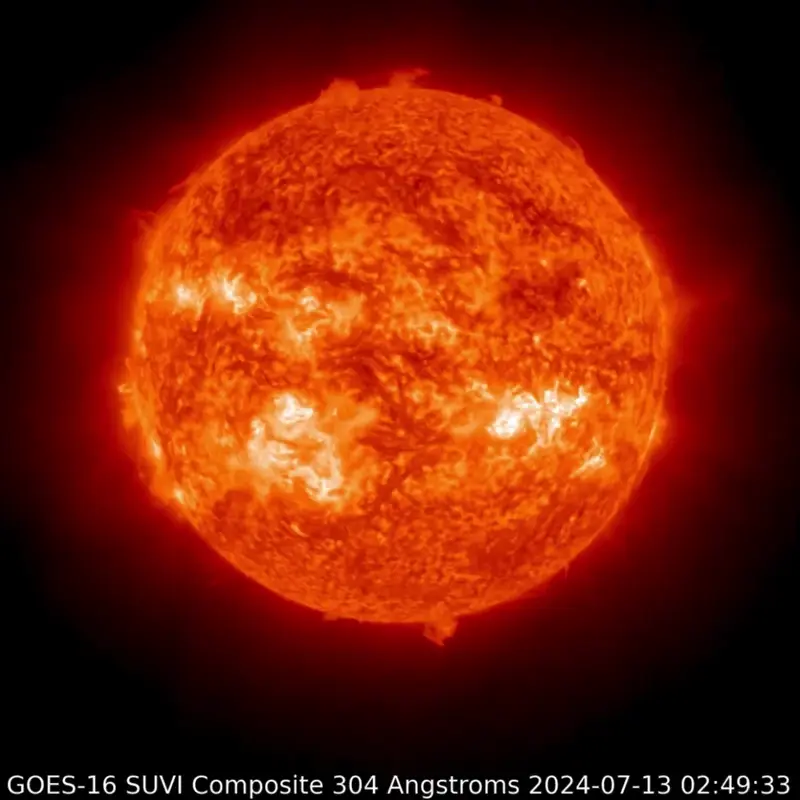
Sun news July 12: A gorgeous prominence erupts from the sun
A beautiful prominence has stolen the limelight on this day of low activity. The billion-ton mass of solar plasma and magnetic field lifted off, unraveling from a twisted rope into a gorgeous ribbon-like structure as it left the sun around 5 UTC on July 12. When prominences like this are Earth-directed, their resulting coronal mass ejections can bring dynamic disturbances to our planet’s magnetic field. But this one was not Earth-directed. Prominence or filament eruptions are one of the origins of CMEs, along with sunspot regions. Some of the most powerful CMEs occur when a filament over a sunspot region erupts due to the erupting sunspot region.
Last 24 hours: Across the Earth-facing side of our star, activity decreased from high to low, with only C flares. AR3738 remained the largest and most complex region of the period, but overall, the current sunspot regions are fairly uneventful. The sun produced 16 C flares during our observation period, between 11 UTC yesterday and 11 UTC today. The largest flare of the period was a C4.1 flare from AR3738 at 15:54 UTC on July 11. AR3738 remained the lead flare producer with 11 C flares. AR3738 has its promising beta-gamma magnetic configuration and is still the largest sunspot group. There is a second active region with a beta-gamma configuration, AR3743. The other sunspot regions have simple alpha or beta configurations. They are stable or in decay. The large coronal hole we have been observing is now located at a geoeffective position, meaning that its fast solar wind may reach Earth, increasing the chances for auroral displays. In particular, the interaction of this fast solar wind and a coronal mass ejection could produce intriguing results. The sun has seven numbered active regions on its Earth-facing side. AR3747 is a newcomer of the period.

Sun news July 11: AR3738 raises sun activity to high
Huge sunspot region AR3738 is living up to expectations. Now with the area of about 4.5 Earths, this region fired 4 out of the 5 M flares produced on the sun over the past day, bringing activity up to high. The region has lost some of its size and magnetic complexity since yesterday, now showing a beta-gamma complexity, but it remains the largest and most complex region on the Earth-facing sun. The SDO imagery above shows the sunspot region over the past day, with red and green indicating different magnetic polarities and the gold lines showing how the magnetic fields connect different sunspots across the region.
Last 24 hours: Five M flares over the past day have brought today’s sun activity to high. During our observation period, between 11 UTC yesterday and 11 UTC today, the sun produced 20 flares: five Ms and 15 C flares. An M1.4 flare from AR3738 was the largest of the period. It occurred at 12:04 UTC on July 10. This caused an R1 (minor) radio blackout over Morocco. Here is the breakdown of today’s M flares:
• M1.4 by AR3738 at 12:04 UTC on July 10. R1 (minor) radio blackout over Morocco.
• M1.1 by AR3738 at 13:04 UTC on July 10. R1 (minor) radio blackout off the northwest coast Africa.
• M1.0 by AR3738 at 15:37 UTC on July 10. R1 (minor) radio blackout over Bermuda.
• M1.3 by AR3745 at 4:23 UTC on July 11. R1 (minor) radio blackout over Guangdong in China.
• M1.2 by AR3738 at 6:25 UTC on July 10. R1 (minor) radio blackout over northeast India.
AR3738 remained the lead flare producer with 14 flares: four Ms and 10 C flares, including the largest M. AR3738 lost its delta region, reducing it to a still-promising beta-gamma magnetic configuration. The region remains the largest sunspot group. The remaining sunspot regions have simple alpha or beta configurations and are stable or in decay. The large coronal hole we have been observing is now located at a geoeffective position, meaning that its fast solar wind may come our way at Earth, increasing the chances for auroral displays. In particular, the interaction of this fast solar wind and a coronal mass ejection launched by the sun could have interesting results. The sun currently has seven numbered active regions on its Earth-facing side, including newcomer AR3745.

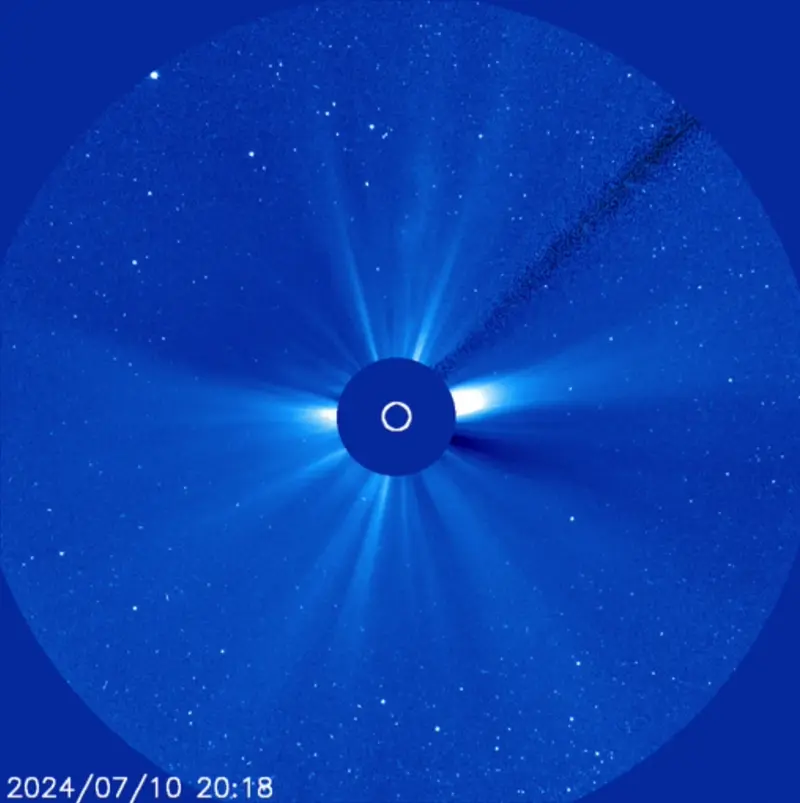
Sun news July 10: AR3738 grows in size and complexity
After a short lull, sunspots are on the rise again. Sunspot region AR3738 is growing swiftly in size and has developed a delta region with beta-gamma-delta magnetic complexity. The greater the magnetic complexity, the higher the potential for flaring. The region already produced 2 M flares prior to 11 UTC today. Will its activity increase? AR3738 rotated into view around July 5 and has grown over six times in size. Today, it has the area of two planet Earths. Will its activity also pick up? But wait! There’s more. Three new regions have rotated into view, two in the south and one in the north. More fun could come. Prominences on the limb (edge) appear as if they’re dancing in response. Stay tuned for more sun news.
Last 24 hours: Two M flares brings today’s sun activity to moderate. Over the past day, between 11 UTC yesterday and 11 UTC today, the sun produced 15 flares: two M and 13 C flares. The largest was an M1.5 flare from active region AR3738 in the southeast at 5:59 UTC on July 10. This caused an R1 (minor) radio blackout over Bangladesh. The region also produced an M1.3 flare at 9:26 UTC. The flare caused an R1 radio blackout over the Middle East. AR3738 is the lead flare producer, with 12 flares, including the two M flares. Active region AR3738 has gained a delta region and now has a beta-gamma-delta magnetic configuration and remains the largest sunspot region. The remaining sunspot regions have simple alpha or beta configurations and are stable or in decay. There is a new large coronal hole on the sun’s northeast quadrant. The sun has eight numbered active regions on its Earth-facing side. The three newcomers on the solar disk are labeled AR3742, AR3743, and AR3744.


Sun news July 9: Jets and prominences lead the day
We have an active sun that is surprisingly calm. Over the last several days, there have been indications of a new region(s) rotating into view. Yesterday, a surge of M flares from over the limb (edge) supported this idea. And today we saw a change, with a reduction to just one M flare over the last 24 hours. Now, does that mean this interesting region is not going to rotate into view? Maybe, but that’s what makes watching the sun so much fun. It’s notorious for surprising us. We do see some sunspots coming into view, as well as lots of solar plage (bright patches). So be patient. We might not see the expected region, but the sun is still very active and more will surely come. The coronal loops over the eastern limb are bright and dynamic. These loops from this mystery region are still a main flare producer, along with AR3738. The other activity over the last 24 hours includes jets from the southwest and some prominences dancing along the limb. A coronal hole in the northeast is rotating toward the central meridian.
Last 24 hours: Sun activity stays at a moderate level but at a reduced M flare production. Between 11 UTC yesterday and 11 UTC today, the sun produced an isolated M flare and 15 C flares. The M1.1 flare came from an as-yet-unnumbered active region over the sun’s southeast limb (edge). The event occurred at 12:41 UTC on July 8. AR3738 kept its beta-gamma magnetic configuration and is currently the largest sunspot region on the solar disk. There is a new large coronal hole on the northeast quadrant. The sun has five numbered active regions on its Earth-facing side. The remaining sunspot regions have simple alpha or beta configurations and are stable or in decay.
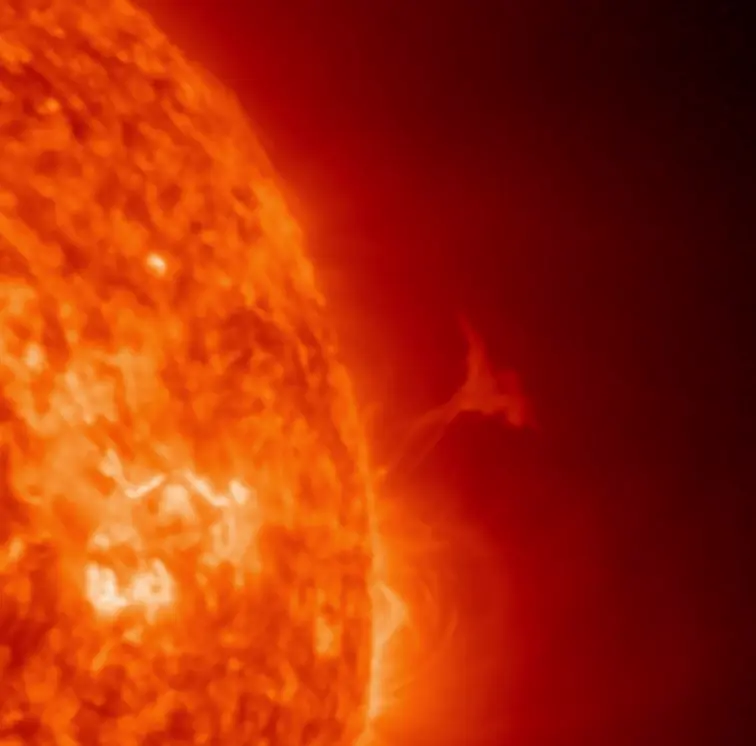
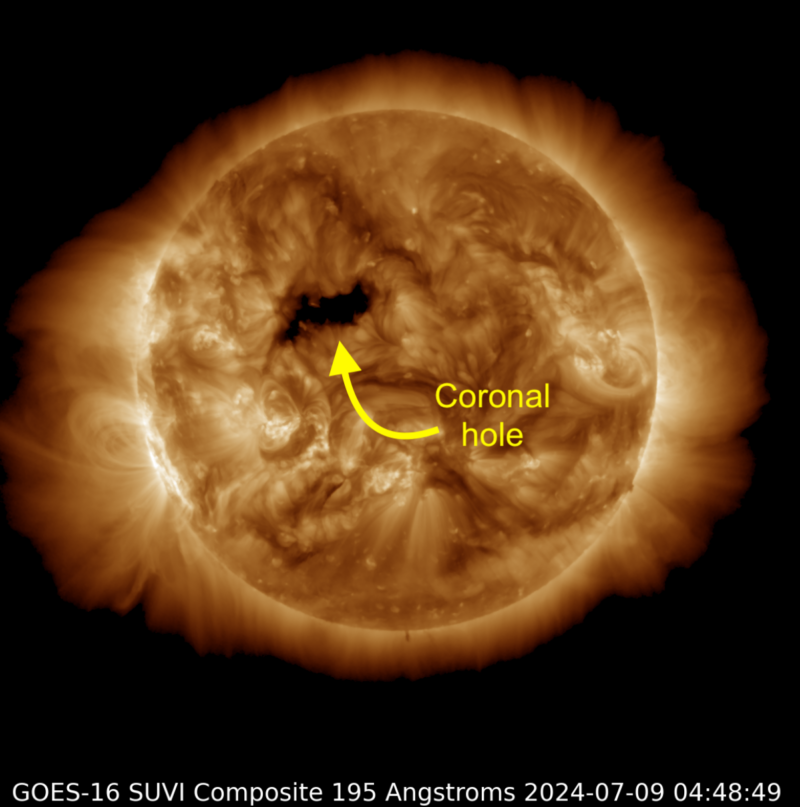
Sun news July 8: Incoming! A new active region
The region we said we were expecting yesterday to rotate into view has now begun its fireworks. Over our 24-hour observation period (11 UTC yesterday to 11 UTC today), this as-yet-unseen region released four of the day’s six M flares. It released the past day’s largest event, an M2.5. Currently, the only part of the region visible are its coronal loops, curving strands of plasma that appear as arcs above the sun’s visible surface. This means that we are not receiving all the emission from the flares of the unseen region. And that means they are larger than we measured. One of the questions remaining is: will the region maintain its magnetic potential by the time it rotates into our view? The region, if it survives, should be here in about one day. Stay tuned!
Last 24 hours: Sun activity is now moderate, with six small M flares. Between 11 UTC yesterday and 11 UTC today, the sun produced the six Ms plus 11 C flares. The largest event was an M2.5 flare from the unnumbered active region over the sun’s southeast limb (edge). The list of M flares is:
• M1.1 at 19:38 UTC on July 7, 2024, from SE limb
• M1.4 at 21:14 UTC on July 7, 2024, from SE limb
• M1.1 at 21:42 UTC on July 7, 2024, from SE limb
• M1.5 at 21:54 UTC on July 7, 2024, from AR3733
• M2.5 at 22:03 UTC on July 7, 2024, from SE limb
• M1.0 at 23:19 UTC on July 7, 2024, from AR3738
AR3728 kept its beta-gamma magnetic configuration. The sun has nine numbered active regions on its Earth-facing side. The remaining sunspot regions have simple alpha or beta configurations and are stable or in decay.
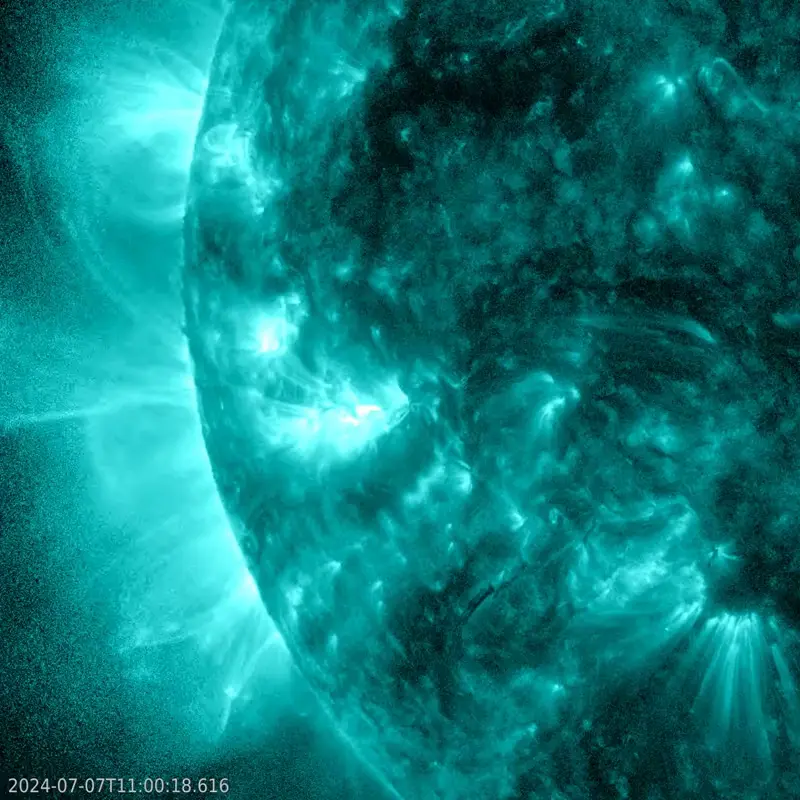
Sun news July 7: A new region over the limb
We are waiting for the appearance of some possibly large sunspot regions over the sun’s eastern limb (edge). In the meantime, we have seen a small increase in flaring size over the 24 hours of observation with an M1.0 flare. Initially, it seemed the flare was just from AR3728, but we can see a large percent of the emission comes from coronal loops rising up over the eastern limb (edge). Are these loops from some of the new region(s) we soon expect to rotate into view? Stay tuned!
Last 24 hours: Sun activity during the past day reached a moderate level, with an isolated M flare. Between 11 UTC yesterday and 11 UTC today, the sun produced one M and 12 C flares. The largest event was an M1.0 flare from active region AR3738 and a set of coronal loops rising from the western limb. AR3728 developed more magnetic complexity with a beta-gamma magnetic configuration. The sun has nine numbered active regions on its Earth-facing side. The remaining sunspot regions have simple alpha or beta configurations and are stable or in decay.
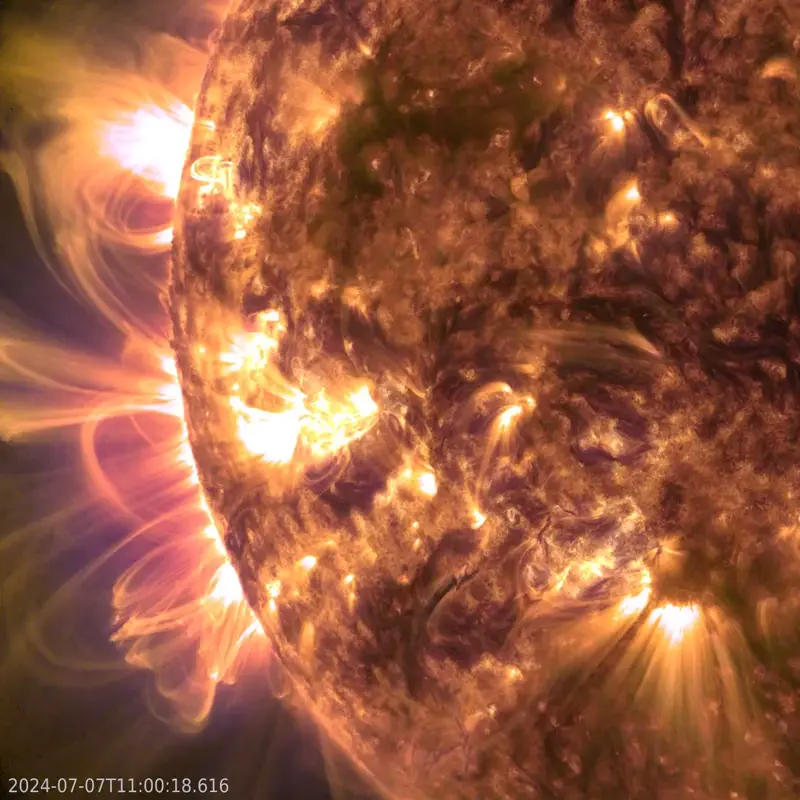
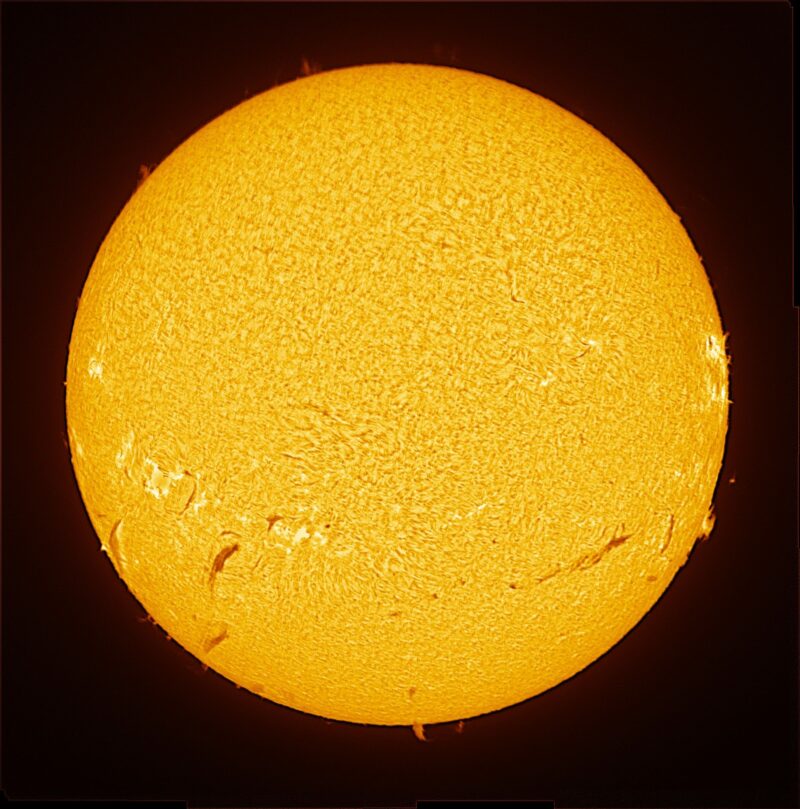
Sun news July 6: Wings in the sun’s corona
The sun has huge wings of solar plasma flowing into space. The bright regions have a wide base, then taper off to a point, extending roughly the width of the sun. These are coronal or helmet streamers. Loops of strong magnetic field trap the solar plasma, suppressing the flow of the solar wind. Material accumulates in these areas, and the solar wind drags it away into elongated, pointed structures. Streamers sit above and between regions of opposite magnetic polarity. Active regions sit beneath streamers, and you can sometimes find prominences under streamers. Often, we can see streamers brighten and expand right before a coronal mass ejection (CME) erupts. The top of the streamer then forms the leading edge of the CME. You can see this happen in the northeast and northwest streamers just below the north pole. The coronal loops below the streamers are visible in the extreme ultraviolet (EUV) images at the center of the video above. Another important aspect of the streamers is their dependence on the solar cycle. Streamers are focused at the equator during solar minimum and become distributed non-symmetrically away from the equator during solar maximum. We can see a few other CMEs during our observation period. None has an obvious coronal component on the solar disk, indicating they are coming from the backside.
Last 24 hours: Sun activity during the past day was at a low level, with only C flares. Between 11 UTC yesterday and 11 UTC today, the sun produced 18 C flares. The largest was an C9.4 flare from active region AR3724 in the southwest. It was produced at 19:03 UTC on July 5. Three active regions – AR3738, AR3724 and AR3729 – are on the spot of main flare producers. AR3729 produced four C flares, while AR3738 and AR3724 produced three C flares each for the time period. AR3729 kept its beta-gamma magnetic complexity. The remaining sunspot regions have simple alpha or beta configurations and are stable or in decay. The sun has seven numbered active regions on its Earth-facing side. The newcomer on the southeast limb (edge) is AR3738.
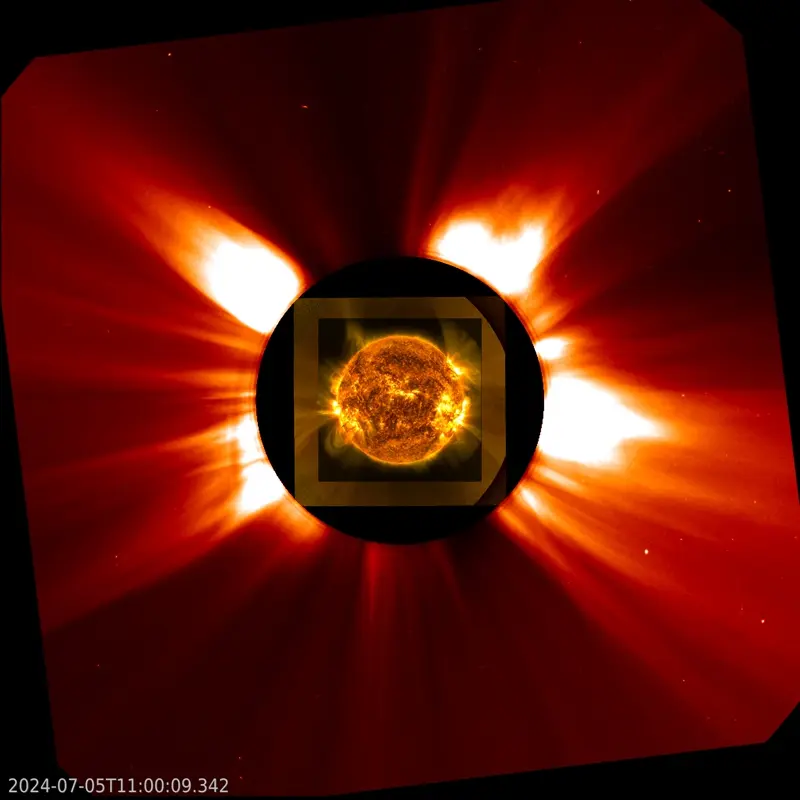
Sun news July 5: Filaments and prominences all over the sun
Even with two M flares bringing activity up to moderate, the most exciting part of the sun’s activity over the past day has been its many filaments and prominences. The solar disk is covered with large ropes of dense solar material (plasma) from lower in the solar atmosphere, supported higher in the solar corona by magnetic fields. These are what we call filaments, but they’re called prominences when we see them overhanging the edge of the sun. Scientists used to think they were different objects, but they eventually realized it was simply a matter of perspective. Today, the sun is filled with filaments across the solar disk, and prominences a full 360° around the solar limb (edge), some over 432,450 miles (696,000 kilometers) long! Take a look and enjoy these beautiful structures.
Last 24 hours: Two small M flares brought solar activity to moderate over the past day. Between 11 UTC yesterday and 11 UTC today, the sun produced 17 flares (two Ms and 15 C flares), up from nine flares yesterday. The largest was an M1.4 flare from AR3730 at 20:05 UTC on July 4. An R1 (minor) radio blackout was registered over the Pacific Ocean off the west coast of Baja in Mexico. The other M flare was an M1.0 flare from AR3723 at 14:25 UTC on July 4, producing an R1 (minor) radio blackout over the Atlantic Ocean. Sunspot region AR3737 was the top flare producer of the period with six flares. The region is now out of sight over the southwest limb (edge). AR3729 kept its beta-gamma magnetic complexity. AR3733 is the largest region in extent, but with a simple beta configuration. The remaining sunspot regions have simple alpha or beta configurations. The sun has seven numbered active regions on its Earth-facing side.
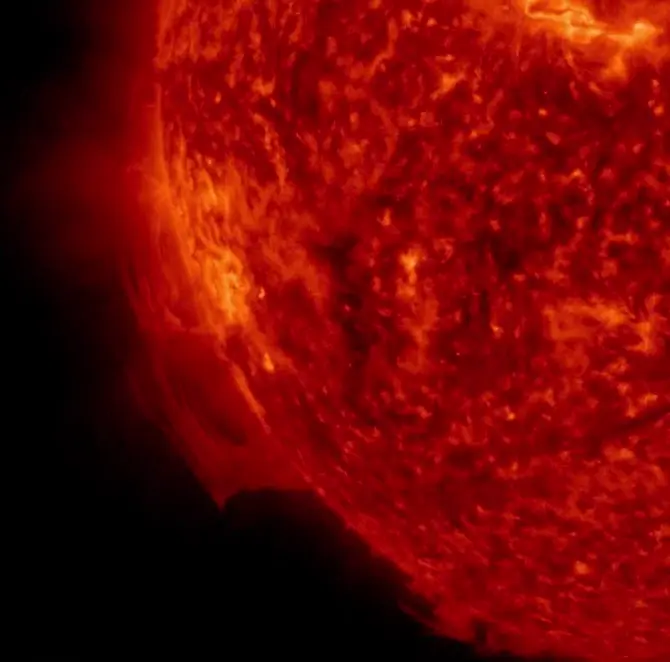
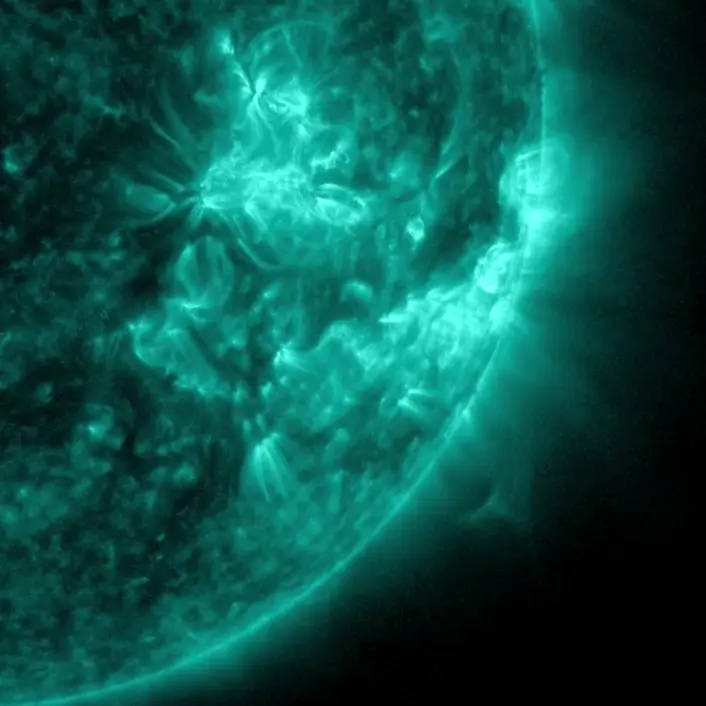
Sun news July 4, 2024: Giant sunspot group on the way
Helioseismology is showing a giant sunspot group on the far side of the sun. Much like seismology on Earth, helioseismology uses vibrations inside the sun to provide snapshots of dense areas on its far side. These areas are dense due to intense concentrations of magnetic fields or sunspots. If this huge region survives, we should start to see signs of its presence as soon as it gets closer to the eastern limb (edge). It should become visible in approximately four days. Stay tuned!
Last 24 hours: Between 11 UTC yesterday and 11 UTC today, the sun produced nine C flares. This means sun activity has dropped to low. The largest flare was a C3.2 from AR3729 at 8:02 UTC on July 4. The lead flare producer of the past day was AR3729, which produced five C flares. This region showed some growth in size, but its magnetic complexity (and therefore its flaring potential) decreased. It’s now showing a beta-gamma configuration. The other ten numbered regions on the Earth-facing sun remain simple, with either alpha or beta configurations. A filament erupted from AR3729 around 11 UTC on July 3.

Sun news July 3, 2024: Flare activity on the rise
We’ve seen an increase in flaring over the past day, with sun activity at moderate levels. This comes after a several-day-lull in activity, even after May and June just set the records for sunspot number and activity levels for the current solar cycle. This reminds us that the apparent state of the sun can change quickly and unexpectedly, especially during Solar Maximum. Will activity continue to increase, or will the sun calm down again? Stay tuned!
Last 24 hours: Between 11 UTC yesterday and 11 UTC today the sun produced a total of 19 flares. An isolated M flare kept sun activity at moderate. The remaining flares were Cs. A beautiful prominence eruption occurred off the northwestern limb (edge) just after 20 UTC on July 2. The largest flare was an M1.5 from AR3730 at 7:29 UTC on July 2. This caused an R1 (minor) radio blackout over western Asia. The lead flare producer of the past day was AR3729, which produced ten C flares. This region showed additional growth, increasing its magnetic complexity to a beta-gamma-delta magnetic complexity configuration. The more complex the magnetic configuration, the greater the potential for flares. The remaining regions remain simple, with either alpha or beta configurations. The sun has 11 numbered active regions on its Earth-facing side.

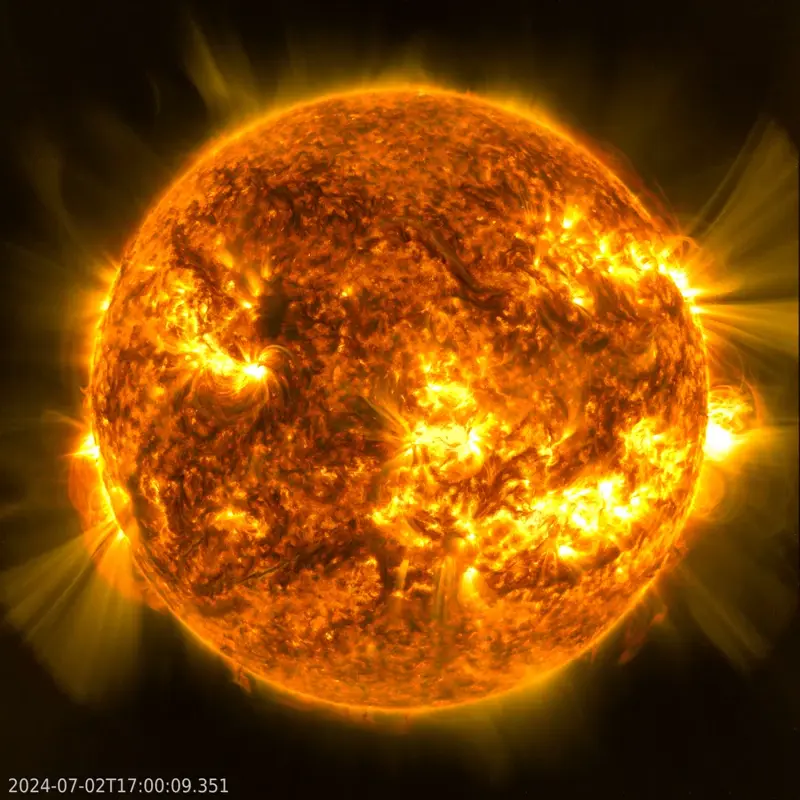
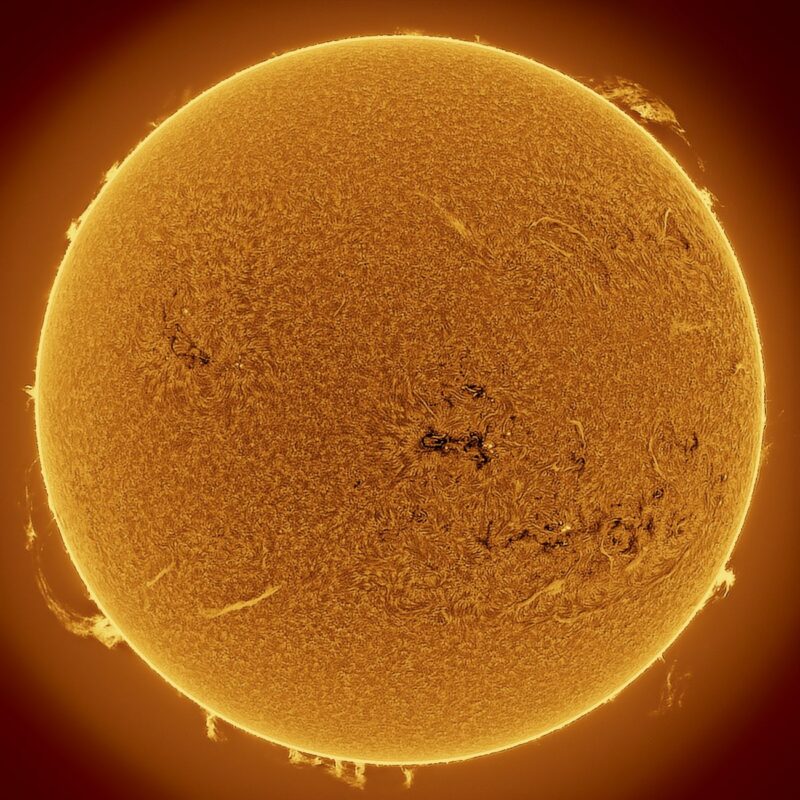
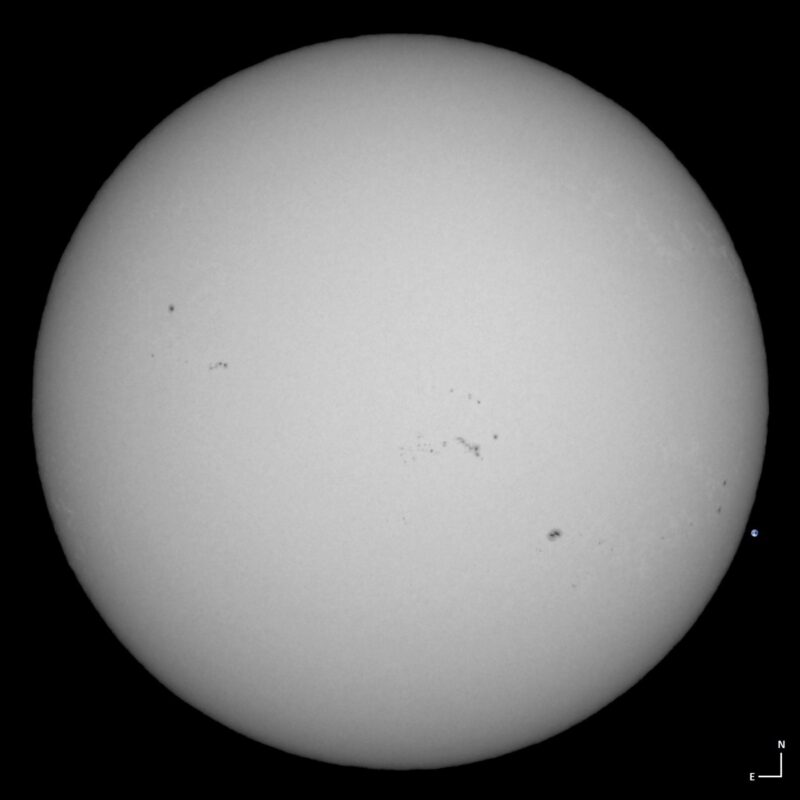
Sun news July 2, 2024: Is Solar Cycle 25 peaking?
It’s now official that June’s sunspot number reached 164, which places last month in 2nd place for the largest number of sunspots for Solar Cycle 25, slightly behind May 2024, with 172 sunspots. The current solar cycle has surpassed all expectations of its size and activity level. We have seen multiple historic geomagnetic storms and intense solar activity over the past several months. Have we seen the peak of the cycle? We still need to wait a few months to make a final determination, but we might be seeing the peak (surely, a peak). Often, solar cycles have two peaks, one for each hemisphere on the sun. It is possible the sun’s northern hemisphere has already peaked in sunspot number. It’s also possible there will be higher future months. We will have to wait and see, so stay tuned!
Last 24 hours: Between 11 UTC yesterday to 11 UTC today the sun produced a total of 18 flares. An isolated M flare brought sun activity to moderate. The remaining 17 flares were C class. The largest flare was an M2.1 flare from AR3730 at 11:02 UTC on June 30. This caused an R1 (minor) radio blackout over Libya. The lead flare producer of the past day was AR3729; it blasted out seven C flares. Also, an as-yet-unnumbered newcomer in the southeast produced six flares. Region AR3739 showed slight growth, increasing its magnetic complexity to a beta-gamma magnetic complexity configuration. The more complex the magnetic configuration, the great the potential for flares. The remaining regions remain simple with either alpha or beta configurations. The sun has 11 numbered active regions on its Earth-facing side this morning.
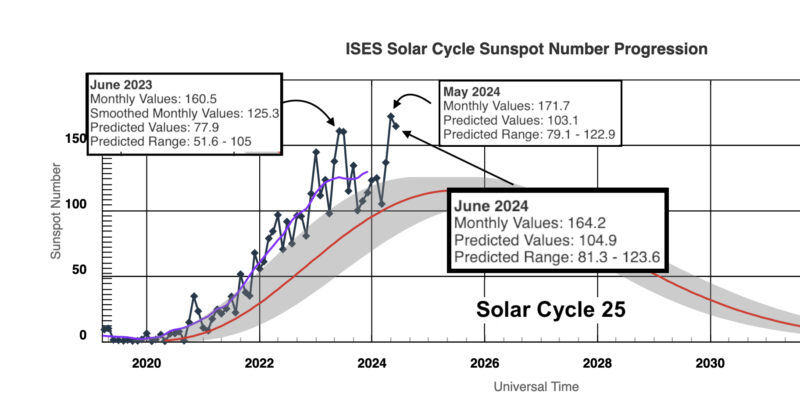
Sun news July 1, 2024: A calm sun day during solar max
Sun activity was low over the past 24 hours. But we’re at or near solar maximum, the peak of the sun’s 11-year cycle! It just goes to show that even an active sun can have periods of calm. These periods can last days or even weeks. On average, as we are closer to solar maximum, the calm periods are shorter. Check out the video above. It shows images of the sun during solar minimum and solar maximum side-by-side. The video shows the sun during a low point of the cycle, June 2019, and June 2024; you’ll quickly see the difference. Looking at the photosphere, the difference between sunspots is very apparent. The difference is also very clear looking at the sun’s upper layers, its chromosphere and corona. The quiet sun during June 2019 is very uniform and simple, in contrast to the active sun of June 2024. We can also see large coronal holes near the poles (polar coronal holes) during quiet times that are not on an active sun. Meanwhile, we see large, complex, and even chaotic loop structures all over the active sun. The current period of calm over the past 24-48 hours – with no M or larger flares or coronal mass ejections (CMEs) – will be over very soon. Stay tuned! NOTE: As we were about to publish today’s updated sun news post, the sun produced two M flares starting just after 11 UTC July 1. The calm is already over.
Last 24 hours: Our observing period is 11 UTC yesterday to 11 UTC today. And during that period, sun activity remained low. This was the case at Earth as well; we had quiet geomagnetic activity. The sun produced 11 C flares during our observation period. The largest event of the past day was a C2.8 flare from AR3727 at 20:56 UTC on June 30. The sun has 15 numbered active regions on its Earth-facing side. All regions have simple magnetic complexity configurations of either alpha or beta.
??Sun news July 1, 2024: A calm sun, during solar max
??It’s a calm Monday on the sun. So how can we tell on a day like today that the sun is still active? Even the active sun (near or during solar maximum) can have periods of calm
MORE at EarthSky: https://t.co/xD29wLfm4e pic.twitter.com/tBM1g3uxfl
— Dr. C. Alex Young (@TheSunToday) July 1, 2024











